
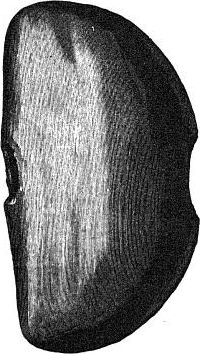
The Project Gutenberg EBook of Illustrated Catalogue of a Portion of the
Collections Made During the Field Season of 1881, by William H. Holmes
This eBook is for the use of anyone anywhere at no cost and with
almost no restrictions whatsoever. You may copy it, give it away or
re-use it under the terms of the Project Gutenberg License included
with this eBook or online at www.gutenberg.org
Title: Illustrated Catalogue of a Portion of the Collections Made
During the Field Season of 1881
Third Annual Report of the Bureau of Ethnology to the
Secretary of the Smithsonian Institution, 1881-82,
Government Printing Office, Washington, 1884, pages 427-510
Author: William H. Holmes
Release Date: October 1, 2006 [EBook #19416]
Language: English
Character set encoding: ISO-8859-1
*** START OF THIS PROJECT GUTENBERG EBOOK ILLUSTRATED CATALOGUE ***
Produced by Louise Hope, Carlo Traverso, and the Online
Distributed Proofreading Team at http://www.pgdp.net (This
file was produced from images generously made available
by the Bibliothèque nationale de France (BnF/Gallica) at
http://gallica.bnf.fr and by First-Hand History at
http://www.1st-hand-history.org)
Illustration notes such as "shown half actual size" have been retained
for completeness. They are not accurate for this e-text.
A few typographical errors have been corrected. They are shown with
mouse-hover popups.
Differences between the Table of Contents and the body text are similarly marked.
| Fig. 116. | Stone implement, Tennessee | 439 |
| 117. | Sections of earthen vessels, Tennessee | 440 |
| 118. | Earthen vessel, Tennessee | 444 |
| 119. | Shell ornament, Tennessee | 447 |
| 120. | Shell ornament, Tennessee | 447 |
| 121. | Shell ornament, Tennessee | 448 |
| 122. | Shell ornament, Tennessee | 448 |
| 123. | Shell ornament, Tennessee | 449 |
| 124. | Shell ornament, Tennessee | 449 |
| 125. | Shell ornament, Tennessee | 450 |
| 126. | Shell ornament, Tennessee | 450 |
| 127. | Shell ornament, Tennessee | 451 |
| 128. | Shell ornament, Tennessee | 452 |
| 129. | Stone implement, Tennessee | 454 |
| 130. | Stone implement, Tennessee | 454 |
| 131. | Stone implement, Tennessee | 455 |
| 132. | Stone implement, Tennessee | 455 |
| 133. | Stone implement, Tennessee | 456 |
| 134. | Stone implement, Tennessee | 459 |
| 135. | Stone implement, Tennessee | 459 |
| 136. | Shell bead, Tennessee | 462 |
| 137. | Shell bead, Tennessee | 462 |
| 138. | Shell bead, Tennessee | 462 |
| 139. | Earthen vessel, Tennessee | 464 |
| 140. | Shell ornament, Tennessee | 466 |
| 141. | Shell ornament, Tennessee | 466 |
| 142. | Stone implement, Arkansas | 470 |
| 143. | Earthen vessel, Arkansas | 471 |
| 144. | Earthen vessel, Arkansas | 472 |
| 145. | Earthen vessel, Arkansas | 473 |
| 146. | Earthen vessel, Arkansas | 473 |
| 147. | Earthen vessel, Arkansas | 474 |
| 148. | Earthen vessel, Arkansas | 474 |
| 149. | Earthen vessel, Arkansas | 475 |
| 150. | Earthen vessel, Arkansas | 476 |
| 151. | Stone implement, Arkansas | 477 |
| 152. | Earthen vessel, Arkansas | 478 |
| 153. | Earthen vessel, Arkansas | 479 |
| 154. | Earthen vessel, Arkansas | 479 |
| 155. | Earthen vessel, Arkansas | 480 |
| 156. | Earthen vessel, Arkansas | 480 |
| 157. | Earthen vessel, Arkansas | 481 |
| 158. | Earthen vessel, Arkansas | 482 |
| 159. | Earthen vessel, Arkansas | 482 |
| 160. | Earthen vessel, Arkansas | 482 |
| 432 161. | Earthen vessel, Arkansas | 482 |
| 162. | Earthen vessel, Arkansas | 483 |
| 163. | Earthen vessel, Arkansas | 483 |
| 164. | Earthen vessel, Arkansas | 484 |
| 165. | Earthen vessel, Arkansas | 484 |
| 163. | Earthen vessel, Arkansas | 485 |
| 167. | Earthen vessel, Arkansas | 486 |
| 168. | Earthen vessel, Arkansas | 487 |
| 169. | Earthen vessel, Arkansas | 488 |
| 170. | Earthen vessel, Arkansas | 489 |
| 171. | Earthen vessel, Arkansas | 489 |
| 172. | Method of plaiting sandals | 493 |
| 173. | Method of plaiting mat | 493 |
| 174. | Earthen vessel, Missouri | 495 |
| 175. | Earthen vessel, Missouri | 496 |
| 176. | Earthen vessel, Missouri | 497 |
| 177. | Earthen vessel, Missouri | 497 |
| 178. | Earthen vessel, Missouri | 498 |
| 179. | Earthen vessel, Missouri | 498 |
| 180. | Earthen vessel, Missouri | 499 |
| 181. | Earthen vessel, Missouri | 499 |
| 182. | Earthen vessel, Missouri | 500 |
| 183. | Earthen vessel, Missouri | 500 |
| 184. | Earthen vessel, Missouri | 501 |
| 185. | Earthen vessel, Missouri | 501 |
| 186. | Earthen vessel, Missouri | 502 |
| 187. | Earthen vessel, Missouri | 502 |
| 188. | Earthen vessel, Missouri | 502 |
| 189. | Earthen vessel, Missouri | 503 |
| 190. | Earthen vessel, Missouri | 504 |
| 191. | Earthen vessel, Missouri | 504 |
| 192. | Earthen vessel, Missouri | 505 |
| 193. | Earthen vessel, Missouri | 505 |
| 194. | Earthen vessel, Missouri | 505 |
| 195. | Earthen vessel, Missouri | 506 |
| 196. | Earthen vessel, Missouri | 506 |
| 197. | Earthen vessel, Missouri | 506 |
| 198. | Wooden mask, Peru | 509 |
| 199. | Stone net-sinker, Peru | 510 |
| 200. | Copper fish-hooks, Peru | 510 |
Mr. Palmer began his explorations early in July, 1881, and continued with marked success until the end of the year.
He first paid a visit to the Cherokee Indians of North Carolina, and collected a large number of articles manufactured or used by this people, besides a number of antiquities from the same region.
From Carolina he crossed into Tennessee, and began work by opening a number of mounds in Cocke County. In September he opened a very important mound, which I have named the McMahan Mound. It is located in the vicinity of Sevierville, Sevier County. Afterwards mounds were opened on Fain's Island, at Dandridge, and at Kingston.
In September he crossed into Arkansas and made extensive explorations at Osceola, Pecan Point, Arkansas Post, and Indian Bay.
It has devolved upon the writer to examine and catalogue this fine collection.
In preparing the catalogue the plan of arrangement already adopted by the Bureau has been carried out; that is, a primary classification by locality and a secondary by material.
The descriptions of specimens are taken from the card catalogue prepared by the writer on first opening the collection, and will be given in full, excepting in cases where detailed descriptions have been furnished in separate papers, either in this or the preceding Annual Report. Cuts have been made of a number of the more interesting specimens. The localities are named in the order of their exploration.
43462953. A small disk of dark-gray slate, 1¼ inches in diameter and 1½ inches in thickness. The form is symmetrical and the surface well polished. The sides are convex, slightly so near the center and abruptly so near the circumference. The rim or peripheral surface is squared by grinding, the circular form being accurately preserved. This specimen was obtained from an aged Cherokee, who stated that it had formerly been used by his people in playing some sort of game. It seems not improbable that this stone has been used for polishing pottery.
62952. A small subglobular pebble used as a polishing stone for pottery.
62954. A polishing stone similar to the above. This implement was seen in use by the collector.
62947. A hemispherical stone, probably used as a nut-cracker.
62944. A stone implement somewhat resembling a thick, round-pointed pick, 4½ inches in length and 1 inch in diameter. It is perforated exactly as an iron pick would be for the insertion of a handle. The perforation has been produced by boring from opposite sides; at the surface it is five-eighths of an inch in diameter, and midway about three-eighths. The material seems to be an indurated clay or soft slate.
The collector suggests that this specimen was probably used for smoothing bow-strings or straightening arrow-shafts.
62949. Eight arrow points of gray and blackish chalcedony.
62950. Pipe of gray, indurated steatite, of modern Cherokee manufacture.
62951. Pipe of dark greenstone, highly polished. It is well modeled, but of a recent type.
62888. Grooved ax of compact greenish sandstone; found near Bakersville, N. C.
Obtained from the Southern Band of Cherokees, Jackson County, North Carolina.
The manufacture of pottery, once so universally practiced by the Atlantic coast Indians, is still kept up by this tribe, rather, however, for 435 the purpose of trade than for use in their domestic arts. The vessels are, to a great extent, modeled after the ware of the whites, but the methods of manufacture seem to be almost wholly aboriginal.
63070. A handled mug or cup of brownish ware. The form is not aboriginal. It is composed of clay, tempered, apparently, with pulverized shell. The surface has a slight polish produced by a polishing implement. The height is 4½ inches and the width nearly the same.
63068. Large flat-bottomed bowl, 6 inches in height, 11 inches in diameter at the top, and 8 at the base. Although made without a wheel, this vessel is quite symmetrical. The thickness is from one-fourth to one-half of an inch. The material has been a dark clay paste with tempering of powdered mica.
63066. A three-legged pot, with spherical body, resembling very closely in appearance the common iron cooking pot of the whites. The rim is 6 inches in diameter, and 1 inch high. The body is 9 inches in diameter. Two handles are attached to the upper part of the body. The form is symmetrical and the surface highly polished. The polishing stone has been used with so much skill that the effect of a glaze is well produced. The materials used were clay and pulverized mica. The color is dark brown.
63067. A strong, rudely made vessel shaped like a half cask. The walls are about one-half an inch in thickness. The surface is rough, the polishing stone having been very carelessly applied.
63068. A flat-bottomed bowl symmetrical in shape but rudely finished.
63063. Basket sieve said to be used to separate the finer from the coarser particles of pounded corn. The coarse meal thus obtained is boiled and allowed to ferment. This is used as food and is called connawhana. The sieve is made of split cane carefully smoothed; some of the strips are dyed red and others brown. A simple ornamental design is worked in these colors. The opening is square, with rounded corners, the sides measuring 14 inches. The depth is 5 inches. The bottom is flat and loosely woven.
63072. A bottle-shaped basket, with constricted neck and rectangular body, used by the Cherokees for carrying fish. Height, 11 inches; width of mouth, 4 inches; diameter of body, 6 inches. It is made of strips of white oak or hickory, one-fourth of an inch in thickness.
63073. Basket made of strips of white oak intended for the storage of seeds and for other household uses. The rim is about 5 inches in diameter; the body is 8 inches in diameter, the base being rectangular and flat.
43663074. Basket, made of cane, used for storing seed.
63076. Two baskets, made of cane, probably used for household purposes. They are neatly ornamented with simple designs, produced by the use of colored strips. The rims are oval in shape, and the bases rectangular. The larger will hold about half a bushel, the smaller about a gallon.
63077. Small basket with a handle, made of splints of white oak. Yellow strips of hickory bark are used to ornament the rim. Other colors are obtained by using bark of different trees, maple, walnut, etc.
63078. Small cup or dish carved from laurel or cucumber wood. It is very neatly made. The depth is about 1 inch; the width 5 inches.
63064. Large spoon, carved from laurel or cucumber wood, used by the Cherokees in handling the connawhana, or fermented meal. The carving is neatly done. The heart-shaped bowl is 6 inches in length, 4 in width, and about 2 in depth. The handle is 12 inches long, and is embellished at the end by a knob and ring. The knob is carved to represent a turtle's or snake's head.
63065. A smaller spoon similar in shape to the above.
63087. A large, five-pronged fork carved from the wood of the Magnolia glauca (?). It resembles the iron forks of the whites.
63088. A small, three-pronged fork of the same pattern and material as the above.
63080. A wooden comb made in imitation of the shell combs used by white ladies for supporting and ornamenting the back hair. The carving is said to have been done with a knife. Considerable skill is shown in the ornamental design at the top. The wood is maple or beech.
63089. A walnut paddle or club, used to beat clothes in washing.
63059. Bow of locust wood, 5 feet long, one-half an inch thick, and 1½ inches wide in the middle, tapering at the ends to 1 inch. The back of the bow is undressed, the bark simply having been removed. The string, which resembles ordinary twine, is said to be made of wild hemp. The arrows are 40 inches in length. The shafts are made of hickory wood and have conical points. Stone and metal points are not used, as the country abounds in small game only, and heavy points are considered unnecessary. In trimming the arrow two feathers of the wild turkey are used; these are close clipped and fastened with sinew.
63057. Blow-gun used by the Cherokees to kill small game. This specimen is 7 feet in length, and is made of a large cane, probably the Arundinaria macrosperma. These guns are made from 5 to 15 feet in length, the diameter in large specimens reaching 1½ inches.
43763058. Arrows used with the blow-gun. The shafts, which are made of hickory wood, are 2 feet in length and very slender. The shooting end has a conical point; the feather end is dressed with thistle-down, tied on in overlapping layers with thread or sinew. The tip of down completely fills the barrel of the gun; and the arrow, when inserted in the larger end and blown with a strong puff, has a remarkable carrying and penetrating power.
63085. Thistle-heads, probably the Cnicus lanceolatus, from which the down is obtained in preparing the arrows of the blow-gun.
63061. Ball-sticks or racquets made of hickory wood. Rods of this tough wood, about 7 feet long, are dressed to the proper shape, the ends having a semicircular section, the middle part being flat. Each is bent and the ends united to form a handle, leaving a pear-shaped loop 6 inches in width by about 12 in length, which is filled with a network of leather or bark strings sufficiently close to hold the ball.
63061. Ball, 1½ inches in diameter, covered with buckskin, used with the racquets in playing the celebrated ball game of the Cherokee, Choctaw, Creek, and Seminole Indians.
63071. Shell, probably a Unio, used by potters to scrape the surface of clay vessels; seen in use.
63081. Comb made of horn. The teeth are 2 inches in length, and have been made with a saw. It is used in dressing the hair.
63085. Charm made of feathers and snake rattles; worn on the head or on some part of the costume.
63082. Awl of iron set in a handle of deer's horn.
43862752. Grooved ax, 8 inches in length, 3½ in width, and about 1 in thickness; one side is quite flat, the other convex. The material is a banded schistose slate.
62758. A fine specimen of grooved ax, 7 inches in length, 4 in width, and 1½ in thickness. The groove is wide and shallow, and is bordered by two narrow ridges, which are in sharp relief all the way around. The material appears to be a greenish-gray diorite.
62759. A grooved ax, 6 inches long, 3½ inches wide, and 1 inch thick. This specimen is similar to the preceding, the groove being deeper on the lateral edges of the implement, and the upper end less prominent. It is made of a fine-grained gray sandstone.
62753. Fragment of a grooved ax, of gray slate. The groove is shallow and irregular.
62754. Celt of compact gray sandstone, somewhat chipped at the ends. It is 6½ inches in length by 2½ in width and 1½ in thickness. One face is flat, the other convex. The sides are nearly parallel. A transverse section would be sub rectangular.
62755. Fragment of celt, 3 inches in length by 2 in width and about 1½ in thickness. The material is a fine grained sandstone or a diorite.
62756. A long, slender celt, very carefully finished, 7 inches in length, 2 in width, and less than 1 in thickness. The material is a very compact gray slate. It has apparently been recently used as a scythe-stone by some harvester.
62757. Fragment of a small, narrow celt, both ends of which are lost. Material, gray diorite.
62760. Heavy celt of gray diorite, 8 inches in length by 3 in width and 2½ in thickness.
62762. A pestle of gray diorite, with enlarged base and tapering top, 5½ inches in length and 3 inches in diameter at the base.
62751. A pestle of banded schistose slate, 15 inches in length, and 2½ inches in diameter in the middle, tapering symmetrically toward the ends, which terminate in rounded points.
43962763. A ceremonial (?) stone resembling somewhat a small broad-bladed pick, the outline being nearly semicircular. It is pierced as a pick is pierced for the insertion of a handle. It is 2½ inches in length, 1½ in width, and three-fourths of an inch in thickness. The material is a soft greenish mottled serpentine, or serpentinoid limestone. Fig. 116.
Fig. 116.
62761. A pierced tablet of gray slate, 4½ inches long, 1½ inches wide, and half an inch thick. The two perforations are 2½ inches apart; they have been bored from opposite sides, and show no evidence of use. Nine notches have been cut in one end of the tablet. It has been much injured by recent use as a whetstone.
62764. Cup stone of rough sandstone, having seventeen shallow cup-like depressions, from 1 to 2 inches in diameter. The stone is of irregular outline, about 10 inches in diameter and 4 in thickness.
62765. A large pipe of gray steatite; the bowl is square and about 3 inches in length, by 1 in diameter. The stem end is 4 inches in length and three-fourths of an inch in diameter. The bowl has a deep, conical excavation. The same is true of the stem-end also.
44062870. The mound from which these fragments were obtained was located 3 miles from Newport. It was 12 feet square and 6 feet high. The original height was probably much greater. The pottery was mixed with ashes and débris of what appeared to be three fire-places. No human remains were found. The fragments are not numerous, nor do they indicate a great variety in form. There is, however, considerable variety in decoration.
Material.—The clay is generally gray or dark-reddish gray in the mass, and is apparently quite siliceous or sandy, numerous grains of quartz being visible. There is generally a sprinkling of finely-powdered mica, but no shell matter can be detected. When much weathered the surface is quite gritty.
Form.—The leading form is a round-bodied, pot-shaped vase. There is one small hemispherical bowl. The outlines have been quite symmetrical. The mouths of the pots are wide, and the necks deeply constricted. The lip or rim exhibits a number of novel features. That of the larger specimen, of which a considerable segment remains, is furnished on the upper edge with a deep channel, nearly one-half an inch wide, and more than one-fourth of an inch deep. First section, Fig. 117. Others have a peculiar thickening of the rim, a sort of collar being added to the outside. This is about 1 inch in width, and is thicker below, giving a triangular section. Third section, Fig. 117.
Fig. 117.
The walls of the vessels are usually quite thin. The bottoms were probably round, or nearly so. No fragments, however, of the lower parts of the vessels were collected. There is but one example of handle, and this presents no unusual features. Middle section, Fig. 117.
Ornamentation.—The ornamentation is in some respects novel. The double or channeled rim of the larger specimen, the mouth of which has been 13 or 14 inches in diameter, is embellished with a line of flutings, which seem to be the impressions of a hollow bone or reed. 441 The whole exterior surface is embellished with a most elaborate ornamental design, which resembles the imprint of some woven fabric. If a woven fabric has not been used, a pliable stamp, producing the effect of a fabric, has been resorted to. The fact that the sharply concave portions of the neck are marked with as much regularity as the convex body of the vessel, precludes the idea of the use of a solid or non-elastic stamp.
The pattern consists of groups of parallel indented lines, arranged at right angles with one another, the puzzling feature being that there is no evidence of the passing of the threads or fillets over or under each other, such as would be seen if a woven fabric had been used. The outer surface of the triangular collar peculiar to many of the pots has been decorated with a herring-bone pattern, made by impressing a sharp implement. The handle in one case is similarly ornamented. This handle has been added after the figure previously described was impressed upon the neck of the vessel. One small fragment shows another style of indented or stamped pattern, which consists of series of straight and curved lines, such as are characteristic of many of the vessels obtained from the Gulf States.
A small fragment of coal-black ware is entirely smooth on the outside, and indicates an unusually well finished and symmetrical vessel. Another shows the impression of basket-work, in which a wide fillet or splint has served as the warp and a small twisted cord as the woof. One interesting feature of this vessel is that from certain impressions on the raised ridges we discover that the vessel has been taken from the net mold while still in a plastic state.
Still another reddish porous fragment has a square rim, which is ornamented with a series of annular indentations.
442On the west fork of the Little Pigeon River, at Sevierville, on a rich bottom, 125 yards from the river, is a celebrated mound, the owners of which have for years refused to have it opened.
Mr. Palmer spent several days in trying to obtain permission to open it, and was about leaving in despair, when the owners finally yielded, not, however, without requiring a number of concessions on the part of the collector, which concessions were put in the form of a legal document.
This mound is 16 feet high and 240 feet in circumference.
Three feet below the surface, a stratum of burnt clay, 15 feet wide by 30 long, was reached. This has probably formed part of the roof of a dwelling.
Beneath this was a bed of charcoal 4 inches thick. In this bed remnants of cedar posts from 2 to 4 inches thick and 1 to 2 feet in length were found.
Below this was a stratum of ashes, covering a limited area to the depth of 4 feet. Surrounding this, the earth contained fragments of numerous articles used by the inhabitants, while beneath came 4½ feet of earth, in which numerous skeletons had been deposited.
The bodies had been interred without order, and the bones were so intermingled, and so far decayed, that no complete skeletons could be collected. Beneath the layer of bones came a second deposit of ashes, 2 feet thick by 2½ feet in diameter, and beneath this a mass of red clay, 18 inches in thickness. In the earth surrounding the ashes and clay, a number of skeletons were found; these were in such an advanced stage of decomposition that only a few fragments of skulls could be preserved.
Three feet below the second layer of bones, the undisturbed soil was reached.
Two boxes of bones were collected, the well-preserved crania numbering about twenty.
A great many interesting specimens of the implements, utensils, and ornaments of the mound-builders were obtained.
The following catalogue includes everything of interest:
62787, 62792, 62778, 62769, 62784, 62788. Numerous specimens of arrow-points, flakes, cores, and rough masses of gray and black chalcedony, obtained partly from the mound, and partly from the soil surrounding it.
44362793. A somewhat conical object of black compact graphite. The flattish base is rubbed off in an irregular way, as if in grinding down for use as a pigment.
62790. Fragment of hammerstone of gray micaceous sandstone, 5 inches long by 3 inches in diameter. It was found associated with the upper layer of skeletons.
62808. Pipe carved from gray marble. The bowl is symmetrically shaped, and resembles a common clay pipe. It is about 1½ inches in height and 1 in diameter. The stem part is about one-fourth of an inch in length. Found with the upper layer of skeletons.
62786. A perforated stone tube, 1¼ inches long and three-fourths of an inch in diameter. It is probably the upper part of a pipe bowl.
62794. A large number of minute quartz pebbles, probably used in a rattle or in playing some game of chance. Found with the skeletons in the mound.
62798. Three glass beads, found 4 feet below the surface of the mound. One is a bright blue bead of translucent glass. One is opaque, resembling porcelain. The third is of blue-gray glass, and has three longitudinal stripes of brown, underlaid by bands of white. All are cylindrical in shape, and are from three-eighths to half an inch in length, and about one-fourth of an inch in diameter.
The collection of pottery from this mound is of much interest. There is but one entire vessel, but the fragments are so plentiful and well preserved that many interesting forms can be restored, and a very good idea of the ceramic work of this locality be formed.
Form.—I have spent much time in the examination of these fragments, and have assigned each to the form of vessel to which it belonged. Where large pieces are preserved, especially if the rim is included, we have little trouble in reconstructing the entire vessel, without fear of being seriously wrong. The lower parts of the bodies of all forms are round or slightly flattened, and but a small fragment of the rim is needed to tell whether the vessel was a bottle, pot, or bowl.
I find, however, that the forms merge into each other in such a way that a complete graduated series can be found. Of first importance, are the round or globular vases with more or less constricted necks.
Ornamentation.—The inside of all forms is plain with the exception of accidental markings of the fingers. The rim is square, sharp, or round on the edge, and sometimes slightly enlarged or beaded on the outer margin. A collar is attached to many forms, which at the lower edge overhangs. It is added to the body with the rim, or as a strip afterward 444 attached. It is often notched or indented with a stick, bone, or reed, or with the fingers.
The necks of vases and pot-shaped vessels have a great variety of handles, knobs, and ornaments. Some of the latter seem to be atrophied handles. In some cases a low horizontal ridge, from 1 to 4 or more inches in length is placed near the rim, in place of the continuous collar. In other cases a narrow, crescent-shaped ridge is attached, the points reaching down on the shoulder, the arch lying upon the neck. Still others have one or more handles which connect the rim with the neck or shoulder of the vessel, leaving a round or oblong passage for a cord or vine.
These handles were added after the vessel was completed. They are never ornamented. In one case an arched handle, like the handle of a basket, connects the opposite sides of the rim. This is the only entire vessel recovered from the mound. It was associated with the upper layer of skeletons. Diameter 4½ inches. Fig. 118.
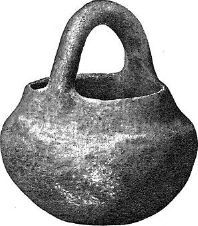
|
| Fig. 118. |
The body of these vessels is sometimes quite plain, but is more frequently covered with cord markings. These, with one or two exceptions, seem to be made by a series of fine cords, approximately parallel, but without cross-threads of any kind. There is little uniformity of arrangement. In the upper part, and about the base of the neck, the indented lines are generally vertical. On the bottom they are quite irregular, as if the vessel, in making, had been rolled about on a piece of netting or coarse cloth. The cords have been about the size of the ordinary cotton cord used by merchants. One exception is seen in a fragment of a large, rudely-made vase, in which we have the impression of a fabric, 445 the warp of which, whether wood or cord, has consisted of fillets more than one-fourth of an inch in width, the woof being fine cord.
This is what is frequently spoken of as the ear-of-corn impression. No incised or excavated lines have been noticed in these fragments of pot-shaped vessels. Some of the most elegant vessels are without upright necks. The upper or incurved surface of the body is approximately flat, forming, with the lower part of the body a more or less sharp peripheral angle. The base is rounded, and, so far as we can judge from the examples, the bottom is slightly flattened. Vessels having vertical or flaring rims are generally somewhat more shallow.
The incurved upper surface is often tastefully ornamented with patterns of incised or excavated lines which are arranged in groups, in vertical or oblique positions, or encircle the vessel parallel with the border. One specimen has a row of stamped circles, made by a reed or hollow bone.
Bowls of the ordinary shape are variously decorated. In one case we have on the outside of the rim, and projecting slightly above it, a rudely-modeled grotesque face. A notched fillet passes around the rim, near the lip, connecting with the sides of this head.
In another case a rude node is added to the rim. The only bowl having a flaring rim is without ornament.
We have only one fragment of a bowl in which the body has been marked with cords.
Composition.—The clay used in the pottery from this mound is generally fine in texture, and of a light-gray color. Many of the fragments have been blackened by burning subsequently to their original firing, and some may have been originally blackened with graphite. The prevailing colors seen in the fragments are yellowish and reddish grays. The percentage of powdered shell used in tempering has usually been very large, forming at times at least half the mass. The flakes of shell are very coarse, being often as much as one-fourth of an inch in diameter. In many cases they have been destroyed by burning, or have dropped out from decay, leaving a deeply pitted surface.
Pipes.—There are a number of pipes in the collection, most of which were found near the surface of the mound. In some cases they resemble modern forms very closely. The most striking example is made of a fine-grained clay, without visible admixture of tempering material. The color is a reddish gray. It is neatly and symmetrically formed, the surface being finished by polishing with a smooth, hard implement, and shaving with a knife. The bowl is 2 inches high, and the rim is bell-shaped above, with a smooth, flat lip, one-fourth of an inch wide. The diameter of the opening is nearly 2 inches. The base is conical. The stem part is one-half an inch long and one-half an inch in diameter. The bowl and stem are both conically excavated.
Another specimen is made of clay mixed with powdered shell. The bowl is cylindrical, being a little larger at the rim, which is ornamented 446 with rows of punctures. The elbow is ornamented by a rosette of indented lines. The mouth piece has been broken away.
62797. One of the most instructive finds in this mound is a pair of brass pins, of undoubted European manufacture. The collector makes the statement, with entire confidence in its correctness, that they had been encased in the earth at the time of the interment of the bodies. One was associated with the upper and the other with the lower layer of bones. In size and shape they resemble our ordinary brass toilet pin. The head is formed of a spiral coil of wire, the diameter of which is about one-half that of the shaft of the pin. It is also stated by the collector that an iron bolt was found in the lower stratum of bones. This object was unfortunately lost.
62795. A small brass cylinder, found 3 feet 7 inches below the surface of the mound. The thin sheet of which the coil is made is about 1 inch square. The edges are uneven. It was probably used as a bead.
Few mounds have rivaled this in its wealth of shell ornaments. Engraved gorgets cut from the body of the Busycon perversum and large pins from the columellæ of the same shell are especially numerous and well-preserved. Large numbers of beads and unworked shells were also found. All were intimately associated with the skeletons.
While many of the specimens are well-preserved, we find that many are in an advanced stage of decay, and unless most carefully handled, crumble to powder.
Similar shell ornaments are found in mounds in other parts of Tennessee, as well as in neighboring States. These have been pretty fully described in the Second Annual Report.

|

|
| Fig. 119. 62831 | Fig. 120. 62831 |
62830-62839. These pins are all made from the Busycon perversum. The entire specimens range from 3 to 6 inches in length; two are fragmentary, having lost their points by decay. The heads are from one-half to 1 inch in length, and are generally less than 1 inch in diameter. They are somewhat varied in shape, some being cylindrical, others being conical above. The shaft is pretty evenly rounded, but is seldom symmetrical or straight. It is rarely above one-half an inch in diameter, and tapers gradually to a more or less rounded point. The groove of the canal shows distinctly in all the heads, and may often be traced far down the shaft. In a number of cases the surface retains the fine polish of the newly finished object, but it is usually somewhat weathered, and frequently 447 discolored or chalky. These specimens were found in the mounds along with deposits of human remains, and generally in close proximity to the head; this fact suggests their use as ornaments for the hair.
62840-62843. A number of saucer-shaped shell gorgets, the upper edge being somewhat straightened, the result of the natural limit of the body of the shell. Two small holes, for suspension occur near the upper margin. The diameter ranges from 3 to 6 inches.
In studying the design the attention is first attracted by an eye-like figure near the left border. This is formed of a series of concentric circles, and is partially inclosed by a looped band about one-eighth of an inch in width, which opens downward to the left. This band is occupied by a series of conical dots or depressions, the number of which varies in the different specimens. 448 The part of the figure inclosed by this band represents the head and neck of the serpent. To the right of the eye we have the mouth, which is usually shown in profile, the upper jaw being turned upward exhibiting a double row of notches or teeth. The body encircles the head in a single coil, which appears from beneath the neck on the right, passes around the front of the head, and terminates at the back in a pointed tail armed with well-defined rattles. The spots and scales of the serpent are represented in a highly conventionalized manner.
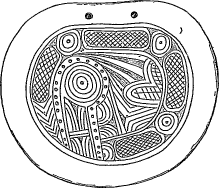 |
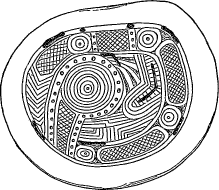
|
| Fig. 121. | Fig. 122. |
| Shell gorgets with engraved designs representing the rattlesnake. | |
62841-62845. The handsome specimen given in Fig. 124 is in a very good state of preservation. It is a deep, somewhat oval plate, made from a Busycon perversum. The surface is nicely polished and the margins neatly beveled. The marginal zone is less than half an inch wide and contains at the upper edge two perforations, which have been considerably abraded by the cord of suspension. Four long curved slits or perforations almost sever the central design from the rim; the four 449 narrow segments that remain are each ornamented with a single conical pit. The serpent is very neatly engraved and belongs to the chevroned variety. The eye is large and the neck is ornamented with a single rectangular intaglio figure. The mouth is more than usually well defined. The upper jaw is turned abruptly backward and is ornamented with lines peculiar to this variety of the designs.
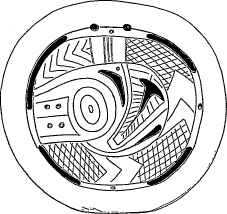 |
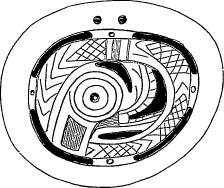
|
| Fig. 123. (62841.) | Fig. 124. (62845.) |
| Shell gorgets with engraved designs representing the rattlesnake. | |
The body of the serpent opposite the perforations for suspension is interrupted by a rather mysterious cross band, consisting of one broad and two narrow lines. As this is a feature common to many specimens, it probably had some important office or significance.
62847-62848. Mask-like shell ornaments. By a combination of engraving and sculpture a rude resemblance to the human features is produced. The objects are generally made from large pear-shaped 450 sections of the lower whorl of marine univalves. The lower portion, which represents the neck and chin, is cut from the somewhat constricted part near the base of the shell, while the broad outline of the head reaches the first suture at the noded shoulder of the body whorl. The simplest form is shown in Fig. 125. A more elaborate form is given in Fig. 126.
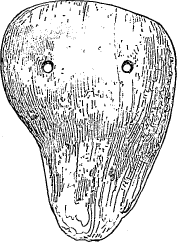
|
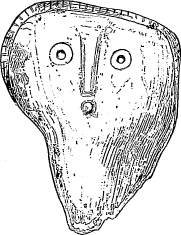
|
| Fig. 125. (62348.) | Fig. 126. (62347.) |
| Mask-like objects of shell. | |
These objects are especially numerous in the mounds of Tennessee, but their range is quite wide, examples having been reported from Kentucky, Virginia, Illinois, Missouri, and Arkansas, and smaller ones of a somewhat different type from New York. In size they range from 2 to 10 inches in length, the width being considerably less. They are generally found associated with human remains in such a way 451 as to suggest their use as ornaments for the head or neck. There are, however, no holes for suspension except those made to represent the eyes, and these, so far as I have observed, show no abrasion by a cord of suspension. Their shape suggests the idea that they may have been used as masks, after the manner of metal masks by some of the oriental nations.
Fig. 127.—Shell gorget with engraving of a curious human figure.
62846. Engraved shell, Fig. 127. This very interesting object has been fully described in the Second Annual Report of the Bureau. The figure is so obscure that considerable study is necessary in making it out.
62930. Engraved shell, Fig. 128. This remarkable specimen has already been described in the Second Annual Report of the Bureau. The engraved design is certainly of a very high order of merit, and suggests the work of the ancient Mexicans.
62816-62822, 62824, 62826, 62828, 62829. Shell beads discoidal and cylindrical in form, made chiefly from the columellæ and walls of marine univalves.
62825. Shell bead made by grinding off the apex of a large Oliva biplicata. (?)
62827. Beads made from Marginella (?) shells.
45262825, 62827, 62850-62857, 62782. Species of shell found in the mound, some with the skeletons, others near the surface.
Fig. 128.—Shell gorget with engraved design representing two fighting figures.
The following genera and species are provisionally determined:
Unio multiplicatus.
Uhio ovatus.
Unio crassidens.
Unio victorum.
Marginella (?).
Oliva (?).
Io spinosa.
Trypanostoma anthonyi.
Anculosa subglobosa.
Busycon perversum.
62823. A tooth-shaped fresh-water pearl, found with the skeletons.
45362861. Fragments of deer-horn found near the surface of the mound.
62858. An implement of unusual form, made from a flat piece of bone, found with the skeletons in the mound.
62859, 62860. Bone implements, needles and perforators, some of which are well preserved and retain the original polish; others are in a very advanced stage of decay.
Three boxes of human bones (not numbered).
62770. A small grooved ax, formed of a coarse textured stone, resembling diorite. It is 4½ inches in length and 2½ in width. The head is rounded and the cutting edge much battered. The groove is wide and shallow, and the bordering ridges prominent. The blade thins out quite abruptly. Presented by J. B. Emert.
62772. A celt 6¾ inches long, 2½ inches wide, and 1 inch thick. The material is a compact, blue-gray, banded slate. The sides are straight and a transverse section is somewhat rectangular. Both edges are sharpened, and are very neatly beveled and polished. Presented by W. P. Mitchell.
62771. A small celt of compact greenish slate; one face is flat, the other convex. It is neatly made and perfectly preserved, the broader end being oblique and sharp. It is 3-1/8 inches in length.
62777. A rude, much-battered celt of coarse sandstone or diorite. It is 4 inches in length by 2 in width near the cutting edge. The top is somewhat conical.
62774. A large unsymmetrical celt made of coarse yellowish sandstone; one side is much battered. The cutting edge is round and dull. It is 9 inches in length by 5 in width near the broad end and is 1½ inches thick.
62785. A knife-blade-shaped object, apparently a fragment of a winged ceremonial stone. The whole surface is smooth and shows no evidence of use. It is made of fine-grained gray slate. It is 2 inches in length by five-eighths in width.
62775. A bell-shaped pestle made of yellowish gray quartzite. The surface has been evenly roughened by picking, but has become slightly polished on parts most exposed when in use. The base part is subrectangular in section, and the bottom is slightly but evenly convex. The upper part, which has been shaped for convenient grasping by the hand, is evenly 454 rounded at the top. Height, 4½ inches; width, of base, 3½ inches.
62766. A well-formed globe of gritty sandstone. The surface is roughened or granular. It is 2½ inches in diameter.
62789. Portion of an oblong hammer stone, 4 inches in length by 3 in diameter in the middle part. One end has been much reduced by use. It is made of some dark, much decomposed, crystalline rock.
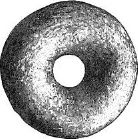 |
| Fig. 129. |
62768. Asymmetrical sandstone ring, 2 inches in diameter and three-fourths of an inch in thickness. The perforation is about five-eighths of an inch in diameter. The surface is roughened by picking.
62767. A symmetrical, neatly finished disk of light gray quartzite. It is 4¼ inches in diameter and 1¼ inches in thickness at the circumference, and less than 1 inch thick at the center.
62869. An hour-glass shaped tube made of gray hydro-mica schist, which resembles very compact steatite. It is 5½ inches long, 2 inches in diameter at the widest part and 1¼ inches at the narrowest part. The most restricted part near the middle is girdled by a ridge or ring, on the circumference of which seventy or eighty shallow notches have been cut.
The perforation is much enlarged at the ends, giving cup-like cavities. The walls are thin near the ends and quite thick near the middle, the passage being hardly more than one-quarter of an inch in diameter. The markings on the inside indicate that the excavation has been made by a gouging process, rather than by the use of a rotary perforator.
Fig. 130.
45562776. A boat-shaped ceremonial stone of banded slate, 3 inches long, 1 inch wide, and 1 inch deep. From the side the outline is triangular, the two lines of the keel forming almost a right angle. From the top the outline is a long, pointed oval, as seen in the illustration, Fig. 131.
Fig. 131.
The trough-shaped excavation is more rounded in outline, and is three-fourths of an inch in depth. Perforations have been made near the ends of this trough; these seem to be somewhat abraded on the outside by a cord of suspension or attachment which has passed between them along a groove in the apex or angle of the keel.
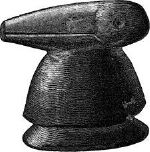
|
| Fig. 132. 62868 |
62868. An amulet or charm of dark-greenish rock, probably a serpentine, carved to represent a bird's head. The more highly polished parts are quite dark, while freshly cut lines are whitish. The head is graphically represented, the bill, the eye, and nostril being well shown. A stand-like base takes the place of the body of the bird. Around this, near the bottom, a groove has been cut for the purpose of attaching a string or securing a handle. In dressing the surface some implement has been used that has left file-like scratches. Fig. 132 represents this object natural size.
45662773. Fragment of a stone disk or wheel that has lines cut upon it resembling in arrangement the grooves of an ordinary millstone. Diameter, 6 inches; thickness, 2 inches. This is probably not an aboriginal work.

|
| Fig. 133. 63186 |
63186. A banner-stone of unusual shape, made of gray slate. The cut, Fig. 133, represents this object three-fourths natural size.
The perforation is one-half an inch in diameter, and is quite symmetrical. The entire surface is well polished.
A few specimens of potsherds were collected from the fields about Sevierville.
Most of these are identical in every way with the pottery of the mound, but three examples are of a totally different type. The material of these is a fine sandy clay, tempered with a large percentage of finely pulverized mica.
The forms of the vessels cannot be made out. The outer surfaces were ornamented by a stamped pattern of small square or lozenge-shaped figures, a number of these together were apparently formed by a single stamp.
Among the fragments we have half a dozen disks, from 1 to 2 inches in diameter, worked from ordinary potsherds. A small rudely modeled figure of a bird was also found with these fragments. There were also masses of indurated clay, which seem to have been used for chinking purposes.
457This mound is situated three hundred and fifty yards from the French Broad River, on the farm of Mr. William Harris.
It is 10 feet high and nearly 50 feet in circumference. Its summit has been cultivated for many years, and the height has doubtless been much reduced. Immediately under the surface soil a heavy bed of ashes and charcoal was reached, which at the border of the mound was only a few inches thick, but at the center was about 3 feet thick.
In this stratum were found a few implements, and fragments of pottery, and two very much decayed skeletons. A part of one cranium was preserved. The mound beneath this stratum was composed chiefly of loam, with some sand in the center, and contained nothing of interest.
62885. A needle-like implement, made of a soft black stone that may be cannel coal. It is 3½ inches in length, but is not entire. The shaft is a little more than one-fourth of an inch in diameter, is nearly round, and tapers to a symmetrical point. The surface is highly polished. It was found in the stratum of ashes.
62890, 62892-6. A considerable number of fragments of pottery was found in the stratum of ashes.
Form.—Vases of the wide-mouthed, round-bodied variety are represented, also a number of hemispherical bowls. One large fragment representing a vessel with rounded bottom was found.
Size.—The pot-like vases have been quite large, the mouths being as much as 14 inches in diameter. The larger bowls have been 10 inches or more in diameter. Others are smaller. The walls of some of the larger vessels have been half an inch in thickness.
Material.—Classified by material, there are two varieties, one is composed of the usual clay and pulverized shells, the latter being coarse and exceedingly plentiful; the other has no shell material, but in its place an admixture of sand and small quartz pebbles.
458 Ornamentation.—The inside is plain as usual, and many of the fragments have no exterior ornament. There are two varieties of surface markings; one consists of impressions of basket work, which indicate a broad series of fillets bound together by small twisted cords of grass or bark; the other appears to have been made by an open net-work of fine cords, which have been quite irregularly arranged.
62898. A shell pin made from the columella of a large univalve. The original polish is still preserved. The head is round and small, and the shaft 2 inches in length. Found in the stratum of ashes.
62899. Two species of shells, Io spinosa and Pleurocera conradii (?), obtained from the stratum of ashes.
62883. A lot of arrow points, spear points, and knives, having a wide range of shape and size. A serrated specimen is 3 inches in length, and is made of yellowish striped chalcedony. One is made of white translucent quartz, and others of dark gray and black chalcedony.
62881. A stone disk, 1¼ inches in diameter and three-eighths of an inch thick. It is of gray sandstone, nicely smoothed. The edge is rounded and the sides slightly convex.
62882. Two stone disks similar to the preceding, but smaller.
62878. A small, thick, nearly symmetrical celt, 2½ inches in length, 1½ inches in width, and one-half of an inch thick. The edge is rounded in outline and well sharpened. The beveled areas are narrow and stand at an angle of 30° with each other. It is widest at the edge, tapering above to a conical point. The material is apparently a compact greenish diorite.
62877. A small celt similar to the preceding in form and material. It is 3¼ inches long, and 1¾ inches in width near the cutting edge, which is considerably battered.
62875. A curved celt of considerable interest, made of a greenish diorite. It is 8 inches in length, 2½ inches wide near the cutting edge, and about 1 inch thick. It tapers toward the apex to 1½ inches in width. A transverse section would be a sharp oval. A longitudinal section showing the thickness of the implement gives a bow-like figure, the median line of which would deflect nearly half an inch from a straight line.
45962876. A celt, 3½ inches in length, of the usual form, made of a greenish diorite.
62874. A grooved ax of gray sandstone, 5 inches long, 3 inches wide, and 1 inch thick. The groove is deep and well rounded, and has two bordering ridges in high relief. The head is low and conical, and the blade narrow and rectangular. The surface has originally been quite smooth, but is now somewhat battered.
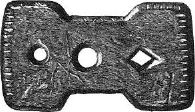
|
| Fig. 134. 62879 |
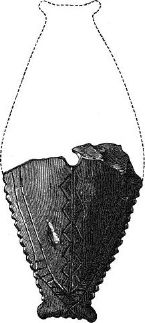
|
| Fig. 135. 62880 |
62871. A cylindrical pestle of gray diorite (?), 11 inches long and 2 inches in diameter. The general surface is rough, the points being smoothed by use.
46062879. A perforated tablet, made of gray, chloritic schist, 2½ inches long by 1½ inches broad, illustrated in Fig. 134. The sides are notched in a way that gives a dumb-bell like outline. The ends are almost square. Series of notches have been cut in the terminal edges. On one of the lateral margins rude notches and zigzag lines have been engraved. In the middle of the plate there is a circular perforation one-fourth of an inch in diameter. Midway between this and the ends are two other perforations, one being circular and one-eighth of an inch in diameter, and the other lozenge or diamond shaped and nearly one-fourth of an inch in width. These show no evidence of wear. The surface is uneven, though somewhat polished. It has probably been used for straightening arrow shafts and shaping strings.
62880. Fragment of a perforated tablet carved from gray slate. It has been broken transversely near the middle, through a perforation which has been about one-eighth of an inch in diameter. The remnant is 2 inches in length and 1½ inches in width at the perforation. One side is plain, the other has a design of plain and zigzag lines. The edges are beveled and notched. See Fig. 135.
On the farm of Mr. M. Biss, three miles from Kingston, on the Tennessee River, a mound was opened which was so located as to overlook the river, and at the same time guard the approach from two pieces of projecting wood. It was 11 feet high, 29 feet wide on the top, and 45 feet in diameter at the base. It was composed entirely of clay.
Three feet from the surface six very much decayed skeletons were found, no parts of which could be preserved. The bodies seem to have been deposited without definite order.
No objects of art were obtained.
Opposite Kingston, on the Clinch River, are three mounds, located on the farm of T. N. Clark. They are all small, and, with the exception of two much decayed skeletons and a single arrow point, contained nothing of interest.
On the farm of S. P. Evans, three miles below Kingston, are three groups of mounds. The first contains five mounds; the second, a little higher up, has the same number, while the third has but two. They are all built of clay, and seem to be without remains of any sort.
461On the farm of J. W. Niles, at this point, is a large mound that has the appearance of a Creek or Cherokee ball-ground. It was flat on the top, and had an area of 1¾ acres. The height was 15 feet. In outline it was somewhat triangular. This mound was also constructed of clay, and contained nothing of interest. In the fields, near by, human bones, pottery, stone implements, beads, etc., are frequently plowed up. From this locality the following specimens were collected:
62957. Arrow heads and knives of gray and black chalcedony.
62955. Unworked Unio shells.
62956. A number of shell beads of usual size and form.
About three hundred yards from the Tennessee River, at Paint Rock Ferry, is a large mound 40 feet in height, and covering an area of about about two acres.
Permission could not be obtained to open the mound, on account of the crop of corn that covered it. Near its base, on opposite sides, were two smaller mounds. One of these was 5 feet high and 10 in diameter, and contained a stone grave. The body which it contained had been laid on the ground and covered a foot deep with earth. A flat rock had been laid upon this, and slabs of limestone set on edge all around. The inclosed space was 4 feet in width by 5 in length. Earth had been used to cover the cist and form the mound.
About this mound were scattered many slabs of stone which had been plowed up during previous years; and it is stated that human bones and various objects of art have, at different times, been brought to light.
A short distance from the large mound, and near the river bank, is another mound on which a barn has been built.
Several hundred yards from the river, in a meadow, is a third mound, less than half as large as that first mentioned. The owner would not allow it to be disturbed. Still another mound, near by, was oval in outline, 28 feet long, by 20 wide, and 12 high. It was composed of clay and contained nothing but a few pieces of pottery.
62939, 62940, 62945. Fragments of pottery from the mounds at Paint Rock Ferry.
62935, 62937. Shell beads, buttons, and pendants, made from marine shells. A neatly made pendant is 1 inch in diameter and one-sixth of an inch thick. Near the edge are two small perforations for suspension, and at the center is a conical pit, encircled by a shallow incised line. Beside this, there are a number of buttons of similar shape, which have single perforations at the center. Some of the smaller beads seem to have been painted red. Figs. 136, 137, and 138.
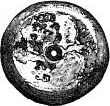
|

|

|
|
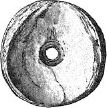
|
| Fig. 136. | Fig. 137. | Fig. 138. | ||
62936. Fragment of a large Busycon perversum.
62942. Teeth of the bear, and possibly of the horse found near the surface of one of the mounds.
463This mound is located on the east end of the island. Although it has been under cultivation for many years, it is still 10 feet in height. The circumference at the base is about 100 feet. Near the surface a bed of burned clay was encountered, in which were many impressions of poles, sticks, and grass. This was probably the remains of the roof of a house, which had been about 16 feet long by 15 feet in width. The bed of clay was about 4 inches thick. Beneath this was a layer of charcoal and ashes, with much charred cane. There were also indications of charred posts, which probably served as supports to the roof. Four feet below the surface were found the remains of thirty-two human skeletons. With the exception of seventeen skulls, none of the bones could be preserved. There seems to have been no regularity in the placing of the bodies.
The fragments of pottery from this mound are unusually large and well preserved, and exhibit a number of varieties of form and ornamentation.
Forms.—The prevailing form is a pot-shaped vase, with wide mouth, and rounded body; the neck is short and straight or but slightly constricted. The handles or ears which connect the upper part of the neck with the shoulder are in some cases as much as 3 inches wide. The bowls are mostly hemispherical, but in a few cases have incurved lips, the shoulder being rounded and the base somewhat flattened. The largest specimens have been 11 or 12 inches in diameter. The vases have been somewhat larger.
Material.—Classified by material, there seem to be two varieties, one with a very large percentage of coarsely pulverized shell material, the other without visible dégraissant. The clay is usually fine and apparently without admixture of sand or other impurities. A little comminuted mica may be seen in some cases.
Color.—The prevailing color is a reddish gray, more or less blackened by use. A remarkable variety has a bright red surface, the mass being gray.
Ornamentation.—The ornamentation consists of cord and net impressions, incised lines, stamped figures, indented fillets, and life and fanciful forms modeled in relief.
The study of cord impressions is quite interesting. The cords are twisted and as large as medium twine. These cords appear to have 464 been disconnected, at least, not woven into a fabric, and the impressions are generally nearly vertical about the upper part of the vessel, but below take all positions, the result being a sort of hatching of the lines. This effect may be the result of placing the vessel upon a coarse fabric while the rim was being finished or the handles added.
It seems possible that a loose net of cords, probably with fine crossthreads, is used to suspend the vessel in during the process of modeling. It appears, however, if this has been the case, that the vessel has been taken out of this net before it was burned. Where handles have been added, it will be found that the cord markings have been destroyed by the touch of the fingers. But the body has impressions of the net made after the addition of the handles and ornaments, as the impressions appear on the outside or lower edges of these additions. The lower part of the body may still have been supported by the net during the process of drying; but as some vessels have no cord markings whatever, it is evident that it was not difficult to complete the vessel without the support of the net.
By making a clay impression of one of the fragments I have been able to determine the character of the fabric used. It was loosely woven and quite flexible, the clay often receiving finger impressions through it. It was probably made of grasses or the fibre of bark.
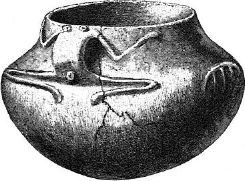
|
| Fig. 139. |
Beside the net and cord marks, which may or may not be the result of an attempt at ornament, there are ornaments made of fillets of clay. In a number of cases a comb-like figure made of thin fillets has been added to the shoulder of a vase. In other cases a fillet has been carried around the neck of the vase and indented by the finger or an implement.
The rim of one bowl has been ornamented with three deeply incised or excavated lines, which form a sort of embattled figure about the incurved lip. Another has a series of shallow, vertical, incised lines near the rim, and a circle of annular indentations, three-eighths of an inch in diameter, about one-fourth of an inch from the lip.
465 There are also various forms of noded ornaments on the rims of bowls. The handles of vases are in a few cases effectively ornamented. In one case the handle has been elaborated into a life form, representing a frog or human figure. The arms are attached to the upper part of the handle and lie extended along the rim. The handle proper represents the body, the breast being protruded. The legs lie flattened out upon the shoulder of the vessel, the feet being bent back beneath the body; height 3½ inches. This vessel is illustrated in Fig. 139.
62906. A very handsome specimen of grooved ax. It is made of a remarkable variety of porphyritic diorite that resembles breccia.
The matrix has the appearance of a gray speckled quartzite; the angular inclusions being whitish feldspar, with dark-greenish patches of hornblende. The surface is smooth and shows but little wear. The length is 7 inches, the width 4, and the thickness 2 inches. The groove is deep, and has two well-defined bordering ridges. The head is low and rounded, and occupies about one-third of the length of the implement. The blade is well-formed, the sides being parallel or nearly so. The edge is slightly rounded in outline, and is polished and sharp.
62907. A grooved stone ax, 5 inches in length, 4½ inches in width, and 1¼ inches in thickness. The groove is placed as in the preceding example, but has a bordering ridge on the upper side only. The head is very large and narrow. The blade is rectangular in outline, and has a rounded, moderately sharp edge. The material is a compact graphic diorite (?).
62904. A grooved ax, 4 inches in length, 3½ inches in width, and three-fourths of an inch in thickness. The groove, which is well defined, has no lateral ridges. It seems to have been made from a flattish, oval, river pebble.
62902. Fragment of a pierced tablet of slate.
62903. A well shaped disk of translucent quartz, 1¾ inches in diameter and three-fourths of an inch in thickness. The sides are nearly flat, and the edge evenly rounded. The surface is quite smooth.
62905. Steatite pipe found on the surface of the mound. The bowl is about 6 inches in length and 1 inch in thickness. A section is nearly square. The cavities are roughly excavated.
46662916. Well preserved specimen of Io spinosa.
62955. Specimens of Unio probatus.
62914. A large specimen of shell pin, made from the columella of a Busycon perversum. It is much discolored and in an advanced stage of decay. Length nearly 4 inches. Form as usual.
62913. A shell pin similar to the preceding.
62931. A number of large shell beads, made from the columellæ of marine shells. The larger specimens are cylindrical in form, and are 1 inch in length and upwards of 1 inch in diameter.
62932-62834. Shell beads of various sizes and shapes, made from the columellæ and walls of marine shells.
46762928. A shell ornament, on the convex surface of which a very curious ornamental design has been engraved. The design, inclosed by a circle, represents a cross such as would be formed by two rectangular tablets or slips, slit longitudinally and interlaced at right-angles to each other. The lines are neatly and deeply incised. The edge of the ornament has been broken away nearly all around. It is represented natural size in the cut. Fig. 140.
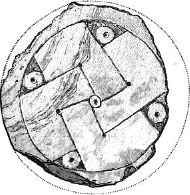
|
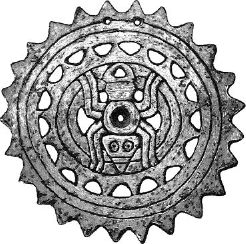
|
| Fig. 140.—Shell gorget with an engraved cross. | Fig. 141.—Shell gorget with the engraving of a spider. |
62929. This disk is somewhat more convex on the front than is indicated in the engraving. It is 2½ inches in diameter, and is quite thin and fragile, although the surface has not suffered much from decay. The margin is ornamented with twenty-four very neatly-made notches or scallops. Immediately inside the border on the convex side are two incised circles, on the 3 outer of which two small perforations for suspension have been made; inside of these, and less than half an inch from the margin, is a circle of seventeen subtriangular perforations, the inner angle of each being much rounded. Inside of this again is another incised circle, about 1¼ inches in diameter, which incloses the highly conventionalized figure of an insect resembling a spider. The middle segment of the body is nearly round and has near the center a large conical perforation. This round portion corresponds to the thorax of the insect and has four pairs of legs attached to it. It is difficult to distinguish the anterior and posterior extremities of the body. It is probable that the subtriangular figure below is intended for the head, as the two circles with central dots are good representations of eyes. Fig. 141.
62910, 62911, 62912. A number of bone implements, including needles, perforators, and paddle-shaped objects, found with the skeletons in the mound.
468On Pemisscott Bayou, 22 miles northwest of Osceola, on the farm of Samuel Hector, is a mound 20 feet in height, with a surface area of about one-fourth of an acre. The sides have been dug into extensively, but the central part remained untouched. It was composed of sand and bluish clay, but contained no remains of interest. It is stated by the proprietor that formerly there were three circular ditches extending around the slopes of the mound. When the surface of the mound was first plowed quantities of charcoal and potsherds were found.
This mound is situated at Chickasawba Village, 24 miles north of Osceola. It is 25 feet high, and covers an area of one-fourth of an acre.
Collectors had already done much work on this mound, but obtained little or nothing. The owner does not wish it disturbed further. A field of several acres near by abounds in fragments of pottery, stone implements, and the remains of houses and camp-fires.
The field contained originally many small mounds or heaps, which were probably the sites of houses. In a number of cases skeletons have been found beneath these heaps.
In Carson Lake township, 6 miles southwest of Osceola, on the farm of Hugh Walker, are three mounds, which were much disturbed by the earthquake that visited the New Madrid district in 1811.
The first one inspected is 59 feet wide by 75 feet long, but exhibits no evidence of having been a dwelling or burial place.
The second mound is about 100 yards from the first, and is circular in outline, having two ridge-like projections from opposite sides. It is 20 feet in height, and about 23 feet across at the top. A number of recent interments have been made near the summit.
The third mound is 250 yards from the preceding, and is 6 feet high, 34 feet wide, and 35 feet long. Six skeletons were found in this mound. A stratum of ashes, charcoal, and burned clay was associated with them. One cranium and a few bones were collected.
46963049. Burnt clay from the third mound just described.
63052. Fragment of a plain vase; interior, reddish; exterior, yellowish-gray. Other fragments are of ordinary undecorated ware.
On the land of R. W. Friend, 1 mile west of the Mississippi River, are two mounds. The one first examined is 5 feet high and 150 feet in circumference. The other is 4 feet high and 75 feet in circumference. Two skeletons were found near the surface of the latter mound.
Near these mounds is another, 4 feet high and 20 feet in diameter. Formerly this mound was covered with large trees, and the roots have penetrated the soil, causing much injury to the contents. It is the opinion of the collector that this mound, as well as many others of the same region, has been used as a dwelling site, and that when a death occurred the dwelling was burned down over the body. Before building again the site was covered with a few inches of earth. There was no uniformity in the position of the graves or their contents. The following objects were obtained from this mound:
63009. A jar-shaped vase, with low neck and much compressed body. Height, 4 inches; width, 5½ inches; surface, moderately smooth; color, almost black.
63022. A jar similar to the preceding, but somewhat taller.
63046. A rather unusual form of bottle-shaped vase. The neck is narrow and tapering. A fillet with finger indentations encircles the lip. The base of the neck is also ornamented with a collar or fillet. The body is globular, apparently a little pointed above. Whole height, 10½ inches; width, 8 inches; color, gray.
63029. A small, large-necked vase, with globular body, and lip a little recurved. The body is ornamented with a number of indentations, probably made with the finger nail. Color, dark gray.
63008. A large, thick-bodied vase, modeled to represent a hunchbacked human figure. The head is missing. It is 9 inches in width, and has been about 12 inches in height. Ware of the ordinary dark variety.
62995. Fragments of steatite vessels which have been from 1 to 2 feet in diameter. The walls about the rims were quite thin.
62959. A large clay pipe, found in the soil near the banks of the Mississippi.
47063204. A large lot of arrow-points of yellow and gray jasper.
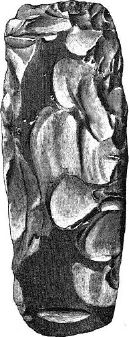
|
| Fig. 142. |
62966, 62976, 62979-62998, 63000-63006. Celts or knives made of jasper and yellowish jaspery slate, which range from 2 to 5 inches in length, and are less than 1 inch in width and half an inch in thickness. They have been chipped into the desired shape, and finished by grinding off the more prominent parts and producing in many eases sharp cutting edges. A good example is shown in Fig. 142.
62965. A flat pebble, with rudely-made notches at the side.
62967, 62968, 62974. Fragments of celts.
62970. Yellowish jasper pebble, resembling a celt.
62000. Fragment of a long, chipped, knife-like implement, the extremities of which are lost.
62975. Fragment of a steatite vessel.
62969, 62971. Sandstone pebbles.
62960. Hammer-stone, with conical points, made from a pebble of cherty sandstone.
47162962. Slightly grooved fragment of rubbing-stone.
62964. Flat pebble, slightly hollowed by use; a sort of shallow mortar.
62961. Fragment of a stone similar to the preceding.
62972. Fragment of concretionary iron ore, concave on one side.
62973. Red paint.
A large number of very fine vessels of clay was presented by Dr. J. M. Lindsley. They were obtained from a field near Pecan Point, within half a mile of the Mississippi River. In the fields is a large mound which could not be opened on account of the crops. Years ago, when the timber was cleared from this field, many small elevations or hillocks were observed scattered irregularly over the surface. The plow has obliterated these, but has brought to light many evidences of ancient 472 occupation, such as charcoal, ashes, burned clay, stone implements, and human bones.
63207. A large, beautifully-formed jar has received this number. The neck is short and slender, and the rim slightly enlarged and recurved. The body is full and symmetrical, but greatly compressed vertically, the width being about twice the height. The ware is of the dark, porous variety. Full height, 8 inches; width, 10 inches.
63010. A bottle-shaped jar or vase, with long neck and globular body. The form is unusually graceful. Height is 10 inches. Diameter of body, 6½ inches. This vessel is shown in Fig. 143.
63012. A well-formed jar, with plain neck and globular body. Seven and one-half inches in height, and 8½ in width.
63013. A medium sized, bottle-shaped vessel, of elegant proportions. A rudimentary foot or stand is added to the bottom. Height, 8 inches. Fig. 144.
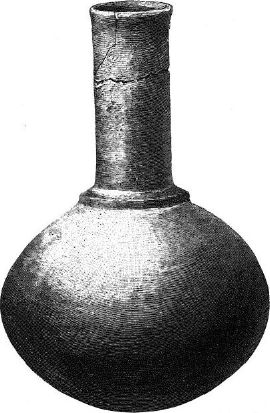
|
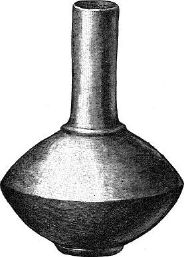
|
| Fig. 144. | |
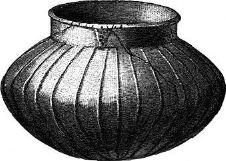
|
|
| Fig. 143. | Fig. 146. |
63017. A small, much compressed, bottle-shaped vase. Height, 5 inches; width, 6½ inches.
63018. A bottle-shaped vase of reddish-gray color, resembling the preceding in shape and size.
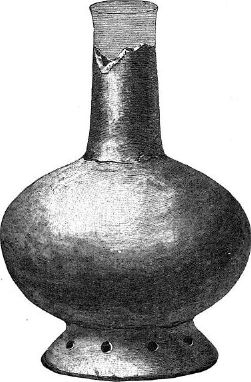
|
| Fig. 145. |
63019. A large, bottle-shaped vase, with long neck and subglobular body. It is unique in having a stand or base which seems to have been added after the body was somewhat hardened. This stand has been perforated for ornament, as shown in Fig. 145. Height, 8 inches; diameter, 6 inches.
47363011. A small vase, ornamented with a series of ribs, which extend around the body from the neck to the base. This vessel is shown in Fig. 146. It is in a fragmentary state. Height, 4¼ inches; width, 7 inches.
47463016. A medium-sized vase with vertically compressed body. Height, 6 inches; diameter, 8½ inches. Fig. 147.
63015. A plain bowl, with flattish bottom. Diameter, 9 inches; height 5 inches.
63014. A well-made jar or vase, with globular body, 6 inches in width and 4½ in height. The surface of the vessel is completely covered with an irregular, bead-like ornamentation, made by pinching the soft clay between the thumb and fingers. Fig. 148. Diameter 5½ inches.
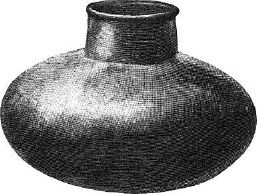
|
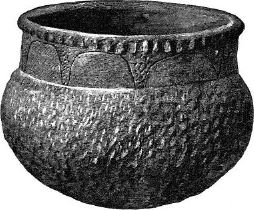
|
| Fig. 147. | Fig. 148. |
63020. A much compressed vase, 4½ inches in height and 7½ in width. Four equi-distant protuberances are placed about the widest part of the body and rudely imitate the extremities of some animal.
47563021. A small, jar-like vase, with globular body, 6 inches in height, and the same in diameter. The form is not quite symmetrical.
63022. A small vase, with large, high neck and much compressed body. Height, 5½ inches; width, 6½ inches.
63023. A vase similar to the preceding.
63024. A medium-sized bowl, 7½ inches in diameter and 3 inches in height. The rim has an exterior ornament of thumb indentations.
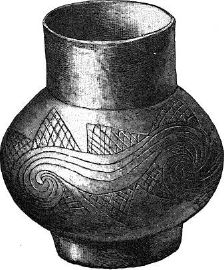
|
| Fig. 149. |
63025. A small, rudely-constructed jar, 4 inches in height and 4½ in width.
63026. A jar having a high, wide neck, and small, globular body. The bottom is flat. Height, 5 inches; width, 4½ inches.
63027. A small, rudely-constructed cup, of a reddish color. Height, 1 inch; width, 1½ inches.
63045. A small, rudely-finished vase, with high, wide neck and short pedestal. The globular body is embellished with an encircling band of scroll-work of incised lines. The scrolls are bordered by triangular wings filled with reticulated lines, as shown in Fig. 149; height, 4¾ inches. Nos. 63113, 63026, and 63099 are plain vessels of similar form.
Additional numbers have been given to numerous fragments from this locality.
476A group of well-known mounds is situated on the farm of the late Frank Menard, 8 miles south-east of the village of Arkansas Post.
The largest mound is 965 feet in circumference at the top and considerably larger at the base. The slopes are covered with trees and bushes.
This mound had already been dug into quite extensively, and it was thought useless to explore it further. Connected with this mound by a ridge of earth 300 feet long and 20 feet across, is a small circular mound, 15 feet high and 45 feet in diameter, which bore evidence of having been occupied by houses.
Near the middle of the connecting ridge, just under the soil, a layer of burnt clay, about 5 or 6 feet in diameter, was found. At one side, imbedded in the débris of clay, a large quantity of fragments of earthen vessels was discovered. They comprise a number of bowls of various sizes, which are all quite new-looking, and are of a type of ware quite distinct from that found in the fields and graves of the same locality. Restorations of a large number have been made, and the collection proves to be extremely interesting.
The collector argues, from the position of the fragmentary vessels, that they had been placed by their owners upon the roof of the house, which, he surmises, was destroyed by fire.
63040, 63034, 63170, 63421, 65412, 65409, 65422, 65405. Plain bowls of yellowish-gray ware, restored from fragments described above. They are wide and shallow, and somewhat conical below; hand-made, and without polish. Composed of clay, tempered with pulverized shell. The walls are usually quite thin. Diameter 10 to 13 inches. Height 3 to 6 inches.
Fig. 150.
47763039, 63033, 63041-63043, 64045, 65406, 65401-65403, 65415,-65417, 65408, 65410. Bowls corresponding in general character to those described above, but having tasteful designs of incised lines and indentations on the exterior surface. The most interesting of these designs consists of series of interlaced or of festooned lines. The exterior margin is encircled, in all cases, by ornaments consisting of parallel lines, groups of short incised lines, or rows of indentations.
Fig. 151.
The principal design encircles the body beneath this, as shown in Figs. 150 and 151.
63037, 63038, 63416. Bowls similar to the above having interior decorations consisting of curved lines.
63035, 63099, 65404, 65411, 65413, 65414, 65418-65420, 65423. Bowls corresponding to the above in general characters, but having flaring rims. They are mostly plain. A few have decorative designs of incised lines. Some have been blackened by use as cooking vessels.
Surrounding the Menard mound is a field containing about twenty acres, which appears at one time to have been the site of a great number of dwellings, as, at a depth of from 1 to 2 feet, layers of burned clay are found. This field seems also to have been a great cemetery, as the remains of skeletons are found in great numbers.
Pottery is found in great abundance. It has, as a rule, been deposited near the heads of the dead, but no ornaments or implements have been discovered with the remains. The frequent plowing of the field has destroyed many earthen vessels, the interments having been made quite near the surface. It is a noticeable fact that the pottery from these graves is of a character quite distinct from that of the mound. It is of the class of ware so common in this region.
47863129, 63122, 63150. Arrow-points, spear-points, and knives of chalcedony, jasper, and quartz.
63132. Celt or chisel of Mack slate, 2½ inches long, and 1¼ wide at the wider end.
63133. Celt of gray diorite. The blade is quite smooth; the upper part is roughened. Length, 3 inches. Width, 1½ inches. Thickness, 1 inch.
63134. Celt of yellow limestone, 2½ inches long, and 1½ inches wide.
63135. A two-edged celt of gray quartzite, 2¼ inches long, and three-fourths of an inch wide.
63136. Celt of yellowish-gray jasper, chipped, and afterwards partially smoothed by grinding. Four and one-half inches long, and 1½ inches wide.
63137. Celt very similar to the preceding.
63138. Celt of dark-gray slate; edge nicely sharpened. Lower part smooth, upper part rough; 4½ inches long, 1½ inches wide, and nearly 1 inch thick.
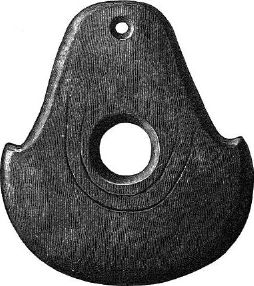
|
| Fig. 152. |
63123. Fragment of a large celt, with conical apex.
63124. A hammer-stone.
63131. A pebble of coarse sandstone, resembling a celt in shape.
63127. A quartz pebble, probably used as a polishing-stone.
63139. A boat-shaped implement of speckled volcanic rock, 3 inches long, 1 inch wide, and three-fourths of an inch thick at the middle part.
47963140. An implement of grayish-red sandstone similar to the above in size and shape. The ends are slightly squared.
63126. A small disk of gray quartzite, having a shallow circular depression in each face.
63128. A pendant of gray slate, somewhat pear-shaped in outline, 1½ inches in diameter, and one-eighth of an inch thick. Near the pointed end, a neat, biconical perforation has been made.
63121. An implement or ceremonial stone of ferruginous slate, possibly a clay iron-stone, or limonite. It has a hatchet-like outline, the blade being semicircular, and the upper part elongated and narrow. A large biconical perforation has been made near the center of the implement; a smaller one, as if for suspension, at the upper end. It is 6¼ inches long, 5½ inches wide, and three-fourths of an inch thick. Fig. 152.
63113. A small reddish cup or vase. The rim is low and wide and is ornamented with four ears placed at regular intervals on the exterior surface. Two of these are pierced as if for the insertion of a string. Height, 3 inches. Width, 5 inches. Fig. 153.
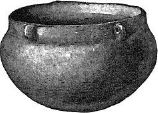
|
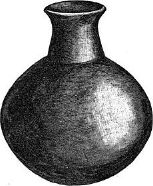
|
| Fig. 153. | Fig. 154. |
63111. A small bottle-shaped vase. The surface has been painted red. Height, 4 inches. Width, 3½ inches. Fig. 154.
48063091. A small globular vase, with low neck of medium width, which has an ornament consisting of a band of clay, slightly raised and indented with oblique lines. Yellowish-gray ware with dark stains. Height, 6 inches.
63108. A low bottle-shaped vase, of yellowish ware, with flaring rim and somewhat flattened body. Height, 5 inches; width 5 inches. Fig. 155.
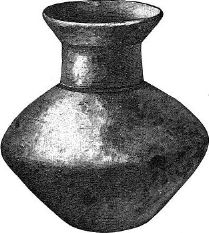
|
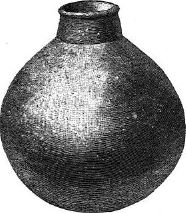
|
| Fig. 155. | Fig. 156. |
63098. A well-made bottle shaped vase, with low neck and globular body, somewhat conical above. Color dark brownish. 7½ inches in height. Shown in Fig. 156.
63090. Fragments of vases corresponding in characters to the preceding. One example has been painted red.
48163110. A small bottle-shaped vase of red ware. Height 6 inches, width 5½ inches.
63102. The body of a small bottle-shaped vase, much flattened, the outline being quite angular at the most expanded part. Yellowish-gray in color and without polish. There are indications that a design in red has ornamented the body. Width 4 inches.
63092. The body of a small bottle-shaped vase, globular in form. Surface painted red and unusually well polished. Diameter 4½ inches.
63100. Neck and upper part of body of a vase resembling in form and color the example last described.
63120. A handsome bottle-shaped vase with flaring lip. The neck widens toward the base. The body is almost globular, being slightly pointed above, and expanded along the equatorial belt. The surface is only moderately smooth. The body is ornamented with a very handsome design of incised lines, which consists of a scroll pattern, divided into four sections by perpendicular lines. The design covers the upper part of the body, the lower part being plain. Height, 9½ inches. Fig. 157.
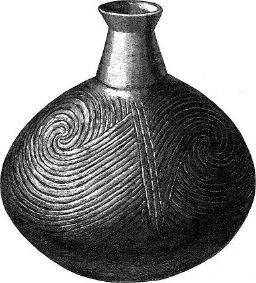
|
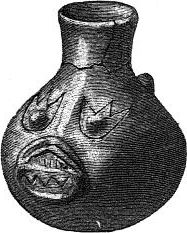
|
| Fig. 157. | Fig. 158. |
63112. A bottle-shaped vessel of dark, rudely finished ware. The body is modeled to represent a fish, the mouth and eyes appearing on one side, and the tail upon the other. Width 3¼ inches. Fig. 158.
48263114, 63117. Two small vessels with globular bodies, which have a curious resemblance to an ordinary tea-pot. A spout has, in each case, been added to the side of the body. Figs. 159 and 160 show these vessels on a scale of one-half.
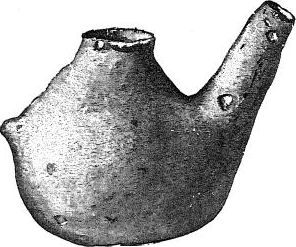
|
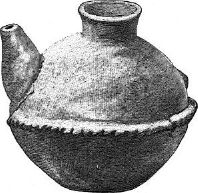
|
| Fig. 159. | Fig. 160. |
63115. An oblong, shallow basin. Wide, flat handles have been added to the rim at the ends of the vessel; one of these is pierced. Length 8¾ inches, width 4 inches, depth 2 inches. Color dark gray. Fig. 161.
Fig. 161.
48363103, 63101, 63169, 63176, 63116, 63199, 63098. Plain bowls of ordinary composition and appearance. Fig. 162 is a good example. Diameter 9 inches.
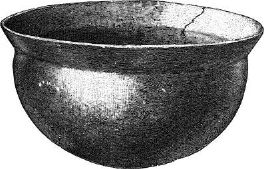
|
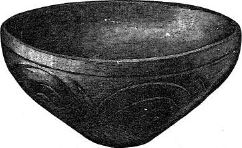
|
| Fig. 162. | Fig. 163. |
63096. A handsome bowl of dark ware. The body is ornamented with an incised design, which consists of a somewhat disconnected running scroll. The bottom, is flat. Diameter 8¼ inches. Fig. 163.
63109. A bowl of dark porous ware, very nicely made. The rim is ornamented at one side with a grotesque head, representing some wild animal, probably a panther. The ornament on the opposite side takes the place of the tail of the animal. Diameter of bowl 8 inches. Fig. 164.
Fig. 164.
63028, 63046. Fragments of many vessels, chiefly of black porous ware, among which are a number of handles representing the heads of birds and quadrupeds, also the fragments of a vessel which restored give the vase shown in Fig. 165. The designs are red on a yellowish ground. Diameter 5½ inches.
Fig. 165.
48463107. A large vase modeled to represent a grotesque human figure. It is painted with designs in red and white, the ground color being a reddish yellow. The figure has a kneeling posture. The hands are upraised against the shoulders, with palms turned forward. Height, 10½ inches; width of shoulders, 8 inches. Fig. 166.
Fig. 166.
48563090, 63054, 63095. Fragments of pottery having incised designs, similar to the dark ware already described. A few of these fragments have been worked into rude disks.
62048. A thin plate of copper, probably intended for a pendent ornament, as two perforations have been made at one end. It is rectangular in outline, and has suffered much from corrosion.
63113. A fragment of galena ore.
63142. Fragment of a needle-like perforator. A conical perforation has been made toward the larger end. The point has been lost.
63047. A cubical fragment of bone, the sides of which have been squared by cutting or grinding.
486On the farm of Daniel Thompson, near Lawrenceville, the remains of ancient habitations are of frequent occurrence.
The fields have been cultivated for many years. In one case a bed of clay 8 inches thick, and covering an area of many hundred feet, was discovered near the surface; this is supposed to be the remains of the roof of a house. Associated with it were a number of objects, among which were five very interesting specimens of pottery.
63151. A large bottle-shaped vase of red and white ware. The upper part of the neck is lost. The body is encircled by an ornamental design in white, upon a red ground, which resembles a rudely drawn Greek fret. The diameter of the body is 9 inches; the height has been 11 or 12 inches.
63152. A fine bottle-shaped vase, resembling the preceding; very handsome, and in a remarkably good state of preservation. It also has a design in red and white. The original color of the 487 vase has been a dull reddish yellow. The neck is red, the body is ornamented with four red and four white figures, which extend from the neck to the base of the vessel. These belts of color are separated by bands of the ground-color of the vessel. Height 12 inches. Fig. 167.
63153. A small rude cup of gray clay, without decoration. Diameter 4 inches.
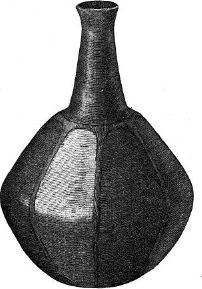
|
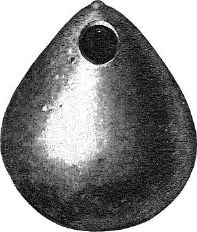
|
| Fig. 167. | Fig. 168. |
63154. An egg-shaped vessel, made in imitation of a gourd. The mouth of this vessel is a small round opening on the side, near the pointed end. The base is somewhat flattened. Height 5 inches. Fig. 168.
63155. A minute cup, 1½ inches in diameter. The rim is encircled by a series of rude notches.
A large mound 30 feet high and 250 feet long is located on the farm of Mr. A. Spencer, near Indian Bay. Our collector, however, could not obtain permission to examine it. At the edge of Indian Bay corporation is another large mound, used as a cemetery by the white residents. In a field near by were two small mounds about 3 feet in height and 30 feet in circumference. In one of these, two feet beneath the surface, a skeleton was found, near the head of which three earthen vessels had been placed. From the other small mound a very interesting collection of pottery was procured, much of which was in a fragmentary condition. 488 From these fragments a number of vessels have been reconstructed. These are given in the following list:
63046. A bottle-shaped vase of dart, grayish-brown ware. The neck is quite high and slender, and the body globular—a little elongated above. The rim and collar are ornamented with incised notches. Height, 10 inches.
63171. A large symmetrically shaped vase or jug of a grayish yellow color. Restored from fragments. The body of the jug is globular, the neck slightly flaring, the rim being notched on the outer edge. The ware is coarse and rough. Height, 10½ inches.
63156, 63163, 63164, 63173, 63174. Fragments of vessels similar to that last described.
63191. A low wide-mouthed vase of dark gray compact ware. The neck is decorated by two series of lines, which cross and recross the neck in such a manner as to form diamond-shaped figures. They are deeply incised. The rim is notched, and has three small nodes on the outer margin. The body is covered with an ornament produced by pinching the clay while in a soft state. Height, 6½ inches; diameter, 9 inches.
63159. A very large wide-mouthed vase, the body of which is conical below. The rim and neck are ornamented in a manner very similar to the one last described. Height, 16 inches; diameter, 19 inches. Fig. 169.
Fig. 169.
48963028, 63029, 63030, 63164, 63166, 63167. Fragments of vessels similar to the one last described.
63192, 63195, 63196. Three small vessels restored from fragments; two of these resemble deep bowls with flaring rims. The lip is notched on the outer margin. The other has an upright, slightly constricted neck, ornamented with a band of rude indentations. Diameter, 6¾ inches. Fig. 170.
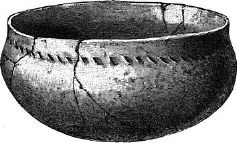
|
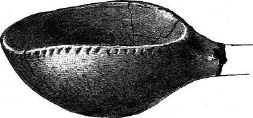
|
| Fig. 170. | Fig. 171. |
63161. A shallow bowl of yellowish gray ware, ornamented with irregular notches about the rim. Diameter, 9 inches.
63197, 63162, 63185. Bowls similar to the preceding.
63194, 63160, 63168. Large bowls with flaring rims.
63176. A very deep bowl. Fragmentary.
63189. A large, handled cup or ladle of yellowish clay. The bowl part is 6 inches in diameter. The extremity of the handle has been lost. Fig. 171.
63157, 63,158. Large portions of the bodies of two vessels of unusual shape.
490During the year 1881 small collections of stone implements and articles of pottery were forwarded to the Bureau by Dr. Wills De Haas.
Most of these are, however, without record, excepting of the most general character.
The majority appear to have been obtained from Warren County, at or in the vicinity of Fort Ancient.
65613. Spear points or knives of gray chalcedony. Three are very sharply pointed, and have probably been used as perforators. Average width 1 inch, average length 2½ inches.
65615. Lot of rudely chipped arrow or spear points of grayish, chalcedony. Notches quite shallow.
65616. A lot of medium-sized, rather heavy arrow points of gray chalcedony.
65617. Lot of neatly shaped, deeply notched spear and arrow points, averaging about 1 inch in width, and ranging from 2 to 3 inches in length. Made of gray chalcedony.
65618. Lot of arrow points, spear points, and knives of various sizes and shapes. Material same as the preceding.
65619. Lot of rudely finished knives and spear points, mostly wide and heavy, some being almost circular in outline. Material same as the preceding.
65620. Lot of large knives and spear points of variously colored chalcedony.
65621. Knives and flakes of chalcedony.
65722. Large lot of long, triangular knives or spear points, made of gray and reddish mottled chalcedony. They average about 2½ inches in length, and 1½ in width.
65623. Large lot of flakes and fragments of gray and dark chalcedony or flint, left from the manufacture of implements.
65434-65451. Celts and fragments of celts of greatly varied size and shape, made of a grayish, speckled rock, resembling diorite.
65429-65430, 65431. Medium-sized, grooved axes-of ordinary forms. One is made of diorite (?), the others of gray rock resembling sandstone.
65426-65428. Very large grooved axes of greenish diorite (?). The largest is 9½ inches long, 5 inches wide, and 3 inches thick.
49165450. Short, heavy pestles with broad bases and conical tops, made of gray diorite or sandstone. Diameter of bases from 2½ to 4 inches. Height from 3 to 6 inches.
65448. A long, heavy, cylindrical pestle.
65464-65492. Bound, oblong, and flattish pebbles, comprising several varieties of stone, used as hammer-stones, nut-crackers, &c., varying from 1 to 6 inches in diameter. The sides of many are flattened or hollowed out by use.
65463. Fragment of cup stone, made of coarse sandstone. On one side two cavities remain; on the other, three. These are about 1¼ inches in diameter, and about one-half an inch in depth.
65449. A grooved stone implement, made from a large pebble of coarse gray stone. The groove about the middle has evidently been made for attaching a handle. The upper lobe has been considerably reduced by picking, and the base, which would correspond to the edge of an ax, has been worked quite flat. Length of lower part 4½ inches. Height of implement 3 inches.
65484. A number of small fragments of pottery of ordinary varieties.
492The following articles were forwarded to the Bureau from John Day River, Oregon, by Captain Bendire:
64102-64113. Arrow-points, knives, and flakes of obsidian, agate, etc., from Indian graves on John Day River.
64125-64139. Fragments of stone implements, including celts, cylindrical pestles, etc., mostly of compact, eruptive rock.
64127. Pipe of gray sandstone, shaped very much like an ordinary straight cigar-holder; 3 inches long, and 1 inch in diameter at the larger end. Obtained from an Indian grave on John Day River.
64126. Fragment of a pipe-stem (?) made of soft black stone, apparently a chloritic slate. A very neat, ornamental design has been engraved upon the cylindrical stem.
64129. Fragment of an ornament carved from greenish sandstone.
493A small collection of ancient relics, obtained from caves in the vicinity of Mammoth Cave, Kentucky, was presented to the Bureau by Mr. Francis Klett.
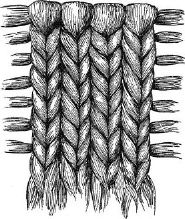
|
| Fig. 172. |
With this collection were a number of articles of stone, some of which were probably obtained from the fields of the same region.
87276. Fragments of gourds.
87277. Two very beautifully knit or plaited sandals. The fiber used has probably been obtained from the inner bark of trees. The combination of threads is shown in Fig. 172. A small piece of matting from the same place is shown in Fig. 173.
Fig. 173.
49427278. Two bundles of charred sticks and reeds.
27280-27283. Spearheads of chert or flint.
27284. Stone knife.
27285. Flake knife.
27286. Small spearheads.
27287. Flint knife.
27288. Arrow heads.
27289. Same; small and thin.
27290-27293. Stone awls or perforators.
27294. Leaden bullet.
27295. Pieces of pottery.
495A fine collection of earthen vessels was purchased for the Bureau from Mr. J. T. Gouden, of Morrow, Ohio, through the agency of Dr. Wills De Haas.
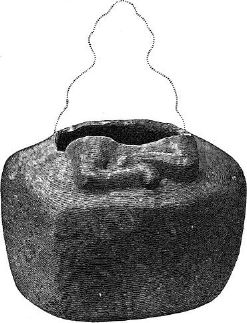
|
| Fig. 174. |
Few facts in regard to them have been furnished, excepting that they were taken from graves in the vicinity of Charleston, Mo. They resemble so closely the well-known types of Missouri pottery that it is safe to conclude that they were obtained from ancient graves and mounds in the locality named.
The numerous cuts accompanying this section are intended for subsequent use in a general treatise on the works of the Moundbuilders.
This ware is generally of the dark gray or black variety, handsmoothed, or but slightly polished, and tempered with pulverized shells.
A few examples are yellowish-red in color. Some of these have been 496 painted red or have been ornamented with designs in red. In one case white paint has been used.
The prevailing form is a bottle-shaped vessel, the neck being frequently high and slender, and the body globular or subglobular. The base is nearly always slightly flattened.
65556. An effigy vase of unusual form. The body is subrectangular. The upper part or neck is lost, but has doubtless been modeled to represent the human figure, as the feet remain attached to the shoulder of the vessel. The color is yellowish gray. Diameter, 5 inches. Fig. 174.
Fig. 175.
65603. An effigy vase of the dark ware. The body is globular. A kneeling human figure forms the neck. The mouth of the vessel occurs at the back of the head—a rule in this class of vessels. Is is finely made and symmetrical. 9¾ inches high and 7 inches in diameter. Fig. 175.
49765595. Effigy vase representing a kneeling or squatting human figure, moderately well modeled. The exterior surface is painted red. Height, 7 inches; diameter, 5 inches. The locality is not known with certainty.
65604-65607, 65611, 65612. Effigy vases of human figures. Sizes, medium to small. The body below the waist is hemispherical, and the legs are not indicated. Fig. 176.
Fig. 176.
65597. Effigy vase, representing an owl. The body is globular. The wings are indicated at the sides, and the legs and tail serve as a tripod when the vessel is placed in an upright position. The head is quite grotesque. This is a usual form in the Middle Mississippi district. Height, 8 inches; width, 5½ inches.
65608. Small example, resembling the preceding.
65601, 65596. Vases with globular bodies; the necks represent an owl's head. Size, medium.
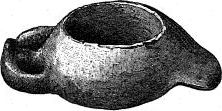
|
| Fig. 177. |
65605. A small vase similar to the above, but having a human head.
65558. A minute vessel modeled to represent a bird, the opening or mouth being on the under side of the body; length, 2 inches. Fig. 177.
49865599, 65602, 65604, 65610. Bottle-shaped vases, with globular or flattish bodies and grotesque tops. The rounded heads are armed with a number of nodes or horns, but no features are shown. The largest is 7 inches in width by 7 in height. Fig. 178.
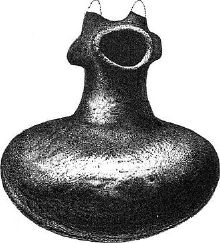
|
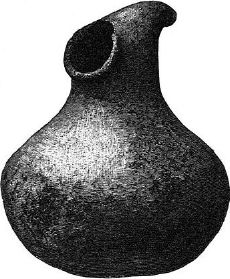
|
| Fig. 178. | Fig. 179. |
65598. Similar vase of medium size. The top is modeled to represent the curved stem and neck of a gourd. Fig. 179. Height 7 inches.
49965600. Vase similar to the above. The top representing a gourd with short conical neck. Four lines are drawn from the stem down the sides which represent the natural markings of the gourd. Height, 5½ inches; diameter, 5½ inches.
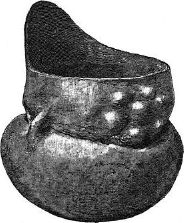
|
| Fig. 180. |
65555. A two-storied vessel, the lower part being a cup of flattened globular form. The upper part is similar in size and shape, but is modeled to represent a univalve shell, the apex being represented by a large node surrounded by six smaller nodes, and the base or spine by a graceful extension of the rim. The groove or depression that encircles the vessel between the upper and lower parts of the body is spanned by two minute handles. Height, 5 inches; width, 4½. Fig. 180.
Fig. 181.
50065543, 65551, 65552, 65554, 65573. Small bowls or cups, made in imitation of shell vessels, the noded apex occurring at one side, and the more or less pointed beak at the opposite side Fig. 181. Another similar specimen with hemispherical body is given in Fig. 182. Length, 6 inches.
Fig. 182.
65542, 65545, 65550. Small vases with wide mouths, the rim and shoulders of which have the heads and extremities of frogs, modeled in relief. Fig. 183. Diameter, 6 inches.
Fig. 183.
65539, 65541, 65544, 65546. Low, wide-mouthed vases or bowls, modeled about the rim to represent sunfish. A vertical view is given in Fig. 184. 5 inches in length.
65579. A small bowl, the rim of which is embellished on one side with the head of a panther, on the other side a flattish projection which resembles a tail.
501
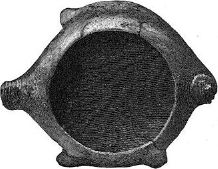
|
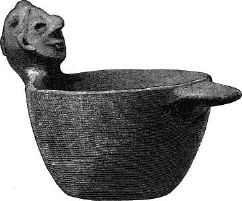
|
| Fig. 184. | Fig. 185. |
65580. A small bowl, having upon the rim a human head, the face of which is turned inward. On the opposite side is the usual flattish projection. Fig. 185. Diameter of bowl 5 inches.
65578. Small bowl, the rim of which is embellished with the head of a fox or wolf; at the opposite side is the usual tail.
65576, 65577, 65581, 65585. Bowls of various sizes, the rims of which are ornamented with the heads and tails of birds. No. 65576 is an unusually fine example. Besides the features described it has been farther embellished by four incised lines which encircle the rim, forming a loop on the opposite sides as seen in Fig. 186. Bowl 9 inches in diameter.
Fig. 186.
65553. Small bowl, the rim of which has been embellished by four pairs of nodes. Fig. 187. Diameter, 6 inches.
502

|
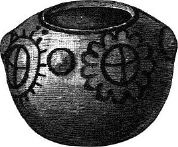
|
| Fig. 187. | Fig. 188. |
65547. A small globular cup of dark ware which has four large nodes about the rim, Between these on the sides of the vessel, four ornamental figures have been painted in red, these consist of an inner circle occupied by a cross, and an exterior circle of rays or scallops. Height, 2½ inches; width, 3½ inches.
The rim has been perforated for the purpose of suspension. Fig. 188.
65487, 65512, 65514, 65519, 65521, 65523, 65525, 65531. Bottle-shaped vases. The bodies are generally globular. A few are conical above, while others are much compressed vertically. Some are slightly ridged about the greatest circumference, while all are slightly flattened on the bottom. The necks are slender and long, being about equal to the body in height. They are generally narrowest in the middle, expanding trumpet-like toward the mouth, and widening more or less abruptly toward the shoulder below. In a few cases a ridge or collar encircles the base of the neck. The exterior surface is generally quite smooth, but never polished, although a polishing implement seems to have been used.
503 The largest is 9 inches in height and 7 inches in diameter. No. 65501 has a very tasteful incised design, encircling the shoulder as shown in Fig. 189. Diameter 6½ inches.
Fig. 189.
65520. Vase similar to the above in form, but with the addition of a base or stand, 1 inch high and 3 inches in diameter at the base.
65486. Same, with the base divided into three parts, forming a kind of tripod, the legs being flat. Fig. 190. Height, 9 inches.
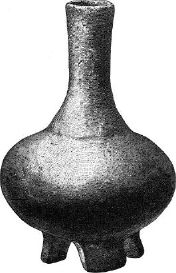
|
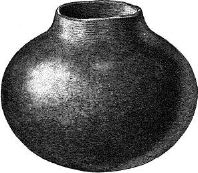
|
| Fig. 190. | Fig. 191. |
65513, 65526, 65530, 65532, 65539. Bottle or jug shaped vases, resembling the preceding, but having wide, short necks. Fig. 191 illustrates a typical form. Height, 4¼ inches.
65485. A vase similar to the above, but of yellowish gray ware, decorated with a design in broad red and white lines. Height, 6 inches; width, 6 inches. Height of neck, 2 inches; width, 3 inches.
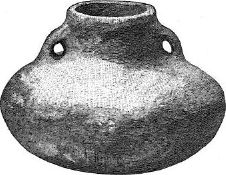
|
| Fig. 192. |
65538. Similar to the above in shape, but with flattish body, and peculiar in having two small handles or ears at the base of the neck. Fig. 192. Diameter, 5 inches.
50465548, 65561, 65562, 65564, 65569. Small caps, with low, wide necks, and globular or subglobular bodies, having two handles or ears which connect the lip with the shoulder.
50565572. A cup like the above, with four handles.
65563, 65565, 65568. Small cups similar to the preceding, but having a variety of indented ornaments about the shoulder and upper part of the body; these ornaments consist of wide vertical lines, or of encircling scalloped lines. Figs. 193 and 194. Diameter of each, 4½ inches.
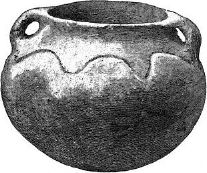
|
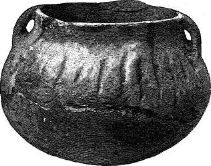
|
| Fig. 193. | Fig. 194. |
65570. Has six nodes about the circumference, and a scalloped figure of three incised lines encircling the vessel above them. The handles have oblique incised lines upon the outer surface.
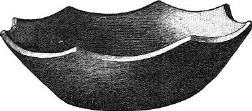
|
| Fig. 195. |
65588, 65590. Bowls with scalloped rims. The largest is 9 inches in diameter and 3 inches in height. Fig. 195.
65574, 65575, 65586, 65587, 65591, 65593. Plain bowls, of various sizes, and somewhat varied shapes. Figs. 196 and 197. Drawn one-half the real size.
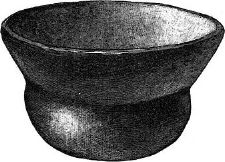
|
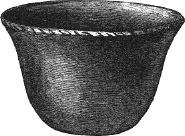
|
| Fig. 196. | Fig. 197. |
65447. Stone implement of unusual form. It may be described as a flattish cylinder tapering slightly toward the ends, which are truncated. In one end a hole has been bored one-half an inch in diameter and three-fourths of an inch deep. A narrow, shallow groove encircles the implement near the middle. The material is a grayish slate. The form is symmetrical and the surface quite smooth.
Found upon the surface in Hamilton County, Indiana.
65353. A copper knife or poinard, with bent point. Found by Edward Daniels while digging a cellar at Ripon, Wis.
65352. A handsome vase, shaped like a bowl with incurved rim, obtained from a mound on the farm of A. C. Zachary, in Morgan County, Georgia. The incurved surface above has an ornamental design of incised lines resembling the Greek fret. The most expanded portion of the vessel is encircled by a raised band, which is neatly ornamented with notches. The lower part of the body is shaped like a bowl with a flattened base. Diameter 9½ inches. Presented by J. C. C. Blackburn.
508A number of interesting articles were presented by Mr. G. H. Hurlbut. These were obtained from ancient graves in the vicinity of Lima by an agent sent out for the purpose by Mr. Hurlbut while the city was invested by the Chilian army. Details of their occurrence were consequently not obtained.
A study of this collection leads to the belief that all the specimens are from one interment, that is, the grave of a single individual. The fact that there is but one skull, one mask-like idol, and but a small number of articles of each, of the classes represented, tends to confirm this supposition.
65377. Skull retaining the scalp and hair. The latter is long, coarse, and black. The lower jaw is missing.
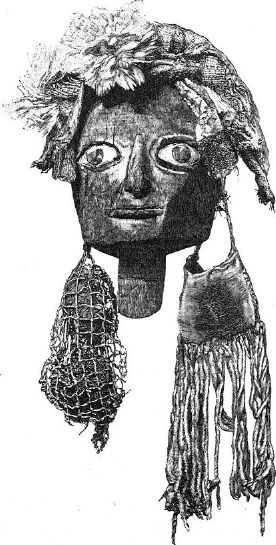
|
| Fig. 198. |
65376. A mask-like wooden figure, the face being somewhat above life-size. Fig. 198. It is of a form not unusual in Peruvian graves. The features are fairly well shown. The eyes are formed by excavating oval depressions and setting in pieces of shell. First, oval pieces of white clam-shell are inserted, which represent the whites of the eye; upon these small circular bits of dark shell are cemented, representing the pupils. Locks of hair have been set in beneath the shell, the ends of which project, forming the lashes of the eye.
The back head is formed by a neatly-rounded bundle of leaves, held in place by a net-work of coarse cord. The edges of the wooden mask are perforated in several places; by means of these the back head, some long locks of fine flax which serve as hair, and a number of other articles have been attached.
Upon the crown a large bunch of brilliantly colored feathers has been fixed; behind this, extending across the top of the head, is a long pouch of coarse white cloth in which a great number of articles have been placed—little packages of beans and seeds, rolls of cloth of different colors and textures, minute bundles of wool and flax and cords, bits of copper and earth carefully wrapped in husks, bundles of feathers, etc.
Encircling the crown are long, narrow bands or sashes, one of which is white, the others having figures woven in brilliant colors. The ends of these hang down at the sides of the face. Attached to one side of the mask by long stout cords is a pouch of coarse cotton cloth resembling a tobacco-bag. It is about 6 inches square. Attached to the lower edge of this is a fringe of long, heavy cords. To the opposite side a 509 net is suspended, in which had been placed innumerable articles, probably intended for the use of the dead—a sling, made of cords, very skillfully plaited; bundles of cord and flax; small nets containing beans, seeds, and other articles; copper fish-hooks, still attached to the lines, which are wound about bits of cornstalk or cane; neatly-made sinkers wrapped in corn-husks, together with a variety of other articles.
510

|
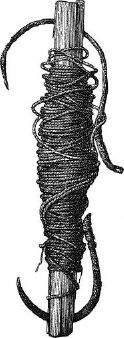
|
| Fig. 199. 1/1 | Fig. 200. 1/2 |
65380, 65382. Sinkers of gray slate, shaped somewhat like a cigar, one or more groves partially encircling the ends. These were carefully wrapped in corn-husks. Fig. 199.
65383, 65384. Two copper fish-hooks and the cords to which they are attached. The hooks pierce the ends of the bit of cornstalk about which the cord is wound. Fig. 200.
65387. A sling, 4 feet long. The extremities consist of a single cord, the middle part of 4 heavy, compactly-plaited cords.
65389. Head-bands of coarse fabrication, having figures of red, yellow and white.
65391. A large piece of cloth, possibly a mantle, made by piecing together fragments of highly-colored cloths.
65390. A large piece of gauze-like white cotton fabric.
65385, 65386. Small nets containing a variety of articles.
65386. A head ornament of red feathers, skillfully attached to cords.
Animal substances, Collection of objects of |
437, 467, 485 |
| Arkansas: | |
| Collections of pottery from | 476-478 |
|
Arkansas County ancient pottery |
476-485 |
| Monroe County ancient pottery | 486-489 |
| B | |
Bendire, Capt. G., sent stone relics from Oregon |
492 |
Blackburn, J. C. S., presented vase from mound |
507 |
| C | |
Cocke County, Tennessee, Collection from |
433, 438-441 |
| Collections in 1881: | |
| bought of J. T. Couden | 495-506 |
| by Capt. C. Bendire | 492 |
| by Dr. Willis De Haas | 490 |
| by G. H. Hurlbut | 508-510 |
| by Edward Palmer | 483-489 |
| from Cherokee Indians | 433-489 |
| from Arkansas: | |
| from Carson Lake township | 468 |
| from Chiokasawha mound | 469 |
| from Lawrenceville | 486 |
| from Menard mound | 447 |
| from Mounds at Arkansas Post | 476 |
| from Pecan Point | 469, 470 |
| from Pemiscott mound | 468 |
| from Georgia | 506 |
| from Indiana | 506 |
| from Missouri | 495-509 |
| from North Carolina | 434, 437 |
| from Ohio mounds | 490-491 |
| from Oregon | 492-494 |
| from Peru, South America | 508-510 |
| from Tennessee: | |
| from Newport | 438 |
| from Junction of Pigeon and French Broad Rivers | 440 |
| from Jefferson County | 463-468 |
| from Roane County | 457-462 |
| from Sevier County | 442-456 |
| from Wisconsin | 506 |
| articles of animal substances | 437, 453, 458, 460, 467 |
| articles of clay | 434, 443, 456, 463, 469, 471-475, 476, 479-485, 487, 488, 491, 495-507 |
| articles of metal | 446, 485 |
| articles of shell | 437, 446, 452-456, 458, 461, 466 |
| articles of stone | 431, 442, 453, 457, 465, 470, 478, 490, 492 |
| articles of vegetal substances | 435 |
| D | |
De Haas, Dr. W., bought Indian relics |
490 |
| collected Indian relics | 494-506 |
| F | |
Fain's Island, Collection of relics from |
463 |
French Broad River, Relics from |
440 |
| G | |
| Gorget, Shell | 488, 466 |
| H | |
Hurlbut, G. H., presented collection from ancient Peruvian graves |
508-510 |
| I | |
Indian Bay, Ark., Collection of Indian relics from |
486 |
| J | |
Jackson County, North Carolina, Indian relics from |
434-437 |
| Jefferson County, Tennessee, | |
| Collection of Indian relics from | 463-468 |
| L | |
Lawrenceville, Ark., Collection of Indian relics from |
486 |
| M | |
| Metal objects from Tennessee | 446 |
Mississippi County, Arkansas, Collection from |
468 |
Missouri, Collection of Indian relics from |
495-507 |
Monroe County, Arkansas, Collection from |
495 |
| N | |
Newport, Tenn., Collection of relics from |
438-441 |
Niles Ferry, Tenn., Collection of relics from |
462 |
North Carolina; Collections from Jackson County |
434-437 |
| O | |
Ohio, Collection of Indian relics from |
490 |
Oregon, collection of Indian relics from |
492-494 |
| P | |
Paint Rock Ferry, Collection from |
461 |
Palmer, E., Collection of Indian relics by |
433-439 |
Peru, Collection of relics from |
508-510 |
Pigeon River, Tenn., Collection of relics from |
440 |
| R | |
Roane County, Tenn., collection of relics from |
457-462 |
| S | |
Sevier County, Tenn., collection of relics from |
441-456 |
Shell objects, Collection of |
437, 446, 448, 450, 452-456, 458, 460, 466 |
Stone objects, Collection of |
431, 442, 453, 457, 465, 470, 478, 490 |
| T | |
Tennessee, Collection of relics from— |
|
| Cocke County | 433, 438-441 |
| Jefferson County | 463-468 |
| Newport | 438-441 |
| Roane County | 457-462 |
| V | |
Vegetal substances, Collections of |
435 |
End of the Project Gutenberg EBook of Illustrated Catalogue of a Portion of
the Collections Made During the Field Season of 1881, by William H. Holmes
*** END OF THIS PROJECT GUTENBERG EBOOK ILLUSTRATED CATALOGUE ***
***** This file should be named 19416-h.htm or 19416-h.zip *****
This and all associated files of various formats will be found in:
http://www.gutenberg.org/1/9/4/1/19416/
Produced by Louise Hope, Carlo Traverso, and the Online
Distributed Proofreading Team at http://www.pgdp.net (This
file was produced from images generously made available
by the Bibliothèque nationale de France (BnF/Gallica) at
http://gallica.bnf.fr and by First-Hand History at
http://www.1st-hand-history.org)
Updated editions will replace the previous one--the old editions
will be renamed.
Creating the works from public domain print editions means that no
one owns a United States copyright in these works, so the Foundation
(and you!) can copy and distribute it in the United States without
permission and without paying copyright royalties. Special rules,
set forth in the General Terms of Use part of this license, apply to
copying and distributing Project Gutenberg-tm electronic works to
protect the PROJECT GUTENBERG-tm concept and trademark. Project
Gutenberg is a registered trademark, and may not be used if you
charge for the eBooks, unless you receive specific permission. If you
do not charge anything for copies of this eBook, complying with the
rules is very easy. You may use this eBook for nearly any purpose
such as creation of derivative works, reports, performances and
research. They may be modified and printed and given away--you may do
practically ANYTHING with public domain eBooks. Redistribution is
subject to the trademark license, especially commercial
redistribution.
*** START: FULL LICENSE ***
THE FULL PROJECT GUTENBERG LICENSE
PLEASE READ THIS BEFORE YOU DISTRIBUTE OR USE THIS WORK
To protect the Project Gutenberg-tm mission of promoting the free
distribution of electronic works, by using or distributing this work
(or any other work associated in any way with the phrase "Project
Gutenberg"), you agree to comply with all the terms of the Full Project
Gutenberg-tm License (available with this file or online at
http://gutenberg.org/license).
Section 1. General Terms of Use and Redistributing Project Gutenberg-tm
electronic works
1.A. By reading or using any part of this Project Gutenberg-tm
electronic work, you indicate that you have read, understand, agree to
and accept all the terms of this license and intellectual property
(trademark/copyright) agreement. If you do not agree to abide by all
the terms of this agreement, you must cease using and return or destroy
all copies of Project Gutenberg-tm electronic works in your possession.
If you paid a fee for obtaining a copy of or access to a Project
Gutenberg-tm electronic work and you do not agree to be bound by the
terms of this agreement, you may obtain a refund from the person or
entity to whom you paid the fee as set forth in paragraph 1.E.8.
1.B. "Project Gutenberg" is a registered trademark. It may only be
used on or associated in any way with an electronic work by people who
agree to be bound by the terms of this agreement. There are a few
things that you can do with most Project Gutenberg-tm electronic works
even without complying with the full terms of this agreement. See
paragraph 1.C below. There are a lot of things you can do with Project
Gutenberg-tm electronic works if you follow the terms of this agreement
and help preserve free future access to Project Gutenberg-tm electronic
works. See paragraph 1.E below.
1.C. The Project Gutenberg Literary Archive Foundation ("the Foundation"
or PGLAF), owns a compilation copyright in the collection of Project
Gutenberg-tm electronic works. Nearly all the individual works in the
collection are in the public domain in the United States. If an
individual work is in the public domain in the United States and you are
located in the United States, we do not claim a right to prevent you from
copying, distributing, performing, displaying or creating derivative
works based on the work as long as all references to Project Gutenberg
are removed. Of course, we hope that you will support the Project
Gutenberg-tm mission of promoting free access to electronic works by
freely sharing Project Gutenberg-tm works in compliance with the terms of
this agreement for keeping the Project Gutenberg-tm name associated with
the work. You can easily comply with the terms of this agreement by
keeping this work in the same format with its attached full Project
Gutenberg-tm License when you share it without charge with others.
1.D. The copyright laws of the place where you are located also govern
what you can do with this work. Copyright laws in most countries are in
a constant state of change. If you are outside the United States, check
the laws of your country in addition to the terms of this agreement
before downloading, copying, displaying, performing, distributing or
creating derivative works based on this work or any other Project
Gutenberg-tm work. The Foundation makes no representations concerning
the copyright status of any work in any country outside the United
States.
1.E. Unless you have removed all references to Project Gutenberg:
1.E.1. The following sentence, with active links to, or other immediate
access to, the full Project Gutenberg-tm License must appear prominently
whenever any copy of a Project Gutenberg-tm work (any work on which the
phrase "Project Gutenberg" appears, or with which the phrase "Project
Gutenberg" is associated) is accessed, displayed, performed, viewed,
copied or distributed:
This eBook is for the use of anyone anywhere at no cost and with
almost no restrictions whatsoever. You may copy it, give it away or
re-use it under the terms of the Project Gutenberg License included
with this eBook or online at www.gutenberg.org
1.E.2. If an individual Project Gutenberg-tm electronic work is derived
from the public domain (does not contain a notice indicating that it is
posted with permission of the copyright holder), the work can be copied
and distributed to anyone in the United States without paying any fees
or charges. If you are redistributing or providing access to a work
with the phrase "Project Gutenberg" associated with or appearing on the
work, you must comply either with the requirements of paragraphs 1.E.1
through 1.E.7 or obtain permission for the use of the work and the
Project Gutenberg-tm trademark as set forth in paragraphs 1.E.8 or
1.E.9.
1.E.3. If an individual Project Gutenberg-tm electronic work is posted
with the permission of the copyright holder, your use and distribution
must comply with both paragraphs 1.E.1 through 1.E.7 and any additional
terms imposed by the copyright holder. Additional terms will be linked
to the Project Gutenberg-tm License for all works posted with the
permission of the copyright holder found at the beginning of this work.
1.E.4. Do not unlink or detach or remove the full Project Gutenberg-tm
License terms from this work, or any files containing a part of this
work or any other work associated with Project Gutenberg-tm.
1.E.5. Do not copy, display, perform, distribute or redistribute this
electronic work, or any part of this electronic work, without
prominently displaying the sentence set forth in paragraph 1.E.1 with
active links or immediate access to the full terms of the Project
Gutenberg-tm License.
1.E.6. You may convert to and distribute this work in any binary,
compressed, marked up, nonproprietary or proprietary form, including any
word processing or hypertext form. However, if you provide access to or
distribute copies of a Project Gutenberg-tm work in a format other than
"Plain Vanilla ASCII" or other format used in the official version
posted on the official Project Gutenberg-tm web site (www.gutenberg.org),
you must, at no additional cost, fee or expense to the user, provide a
copy, a means of exporting a copy, or a means of obtaining a copy upon
request, of the work in its original "Plain Vanilla ASCII" or other
form. Any alternate format must include the full Project Gutenberg-tm
License as specified in paragraph 1.E.1.
1.E.7. Do not charge a fee for access to, viewing, displaying,
performing, copying or distributing any Project Gutenberg-tm works
unless you comply with paragraph 1.E.8 or 1.E.9.
1.E.8. You may charge a reasonable fee for copies of or providing
access to or distributing Project Gutenberg-tm electronic works provided
that
- You pay a royalty fee of 20% of the gross profits you derive from
the use of Project Gutenberg-tm works calculated using the method
you already use to calculate your applicable taxes. The fee is
owed to the owner of the Project Gutenberg-tm trademark, but he
has agreed to donate royalties under this paragraph to the
Project Gutenberg Literary Archive Foundation. Royalty payments
must be paid within 60 days following each date on which you
prepare (or are legally required to prepare) your periodic tax
returns. Royalty payments should be clearly marked as such and
sent to the Project Gutenberg Literary Archive Foundation at the
address specified in Section 4, "Information about donations to
the Project Gutenberg Literary Archive Foundation."
- You provide a full refund of any money paid by a user who notifies
you in writing (or by e-mail) within 30 days of receipt that s/he
does not agree to the terms of the full Project Gutenberg-tm
License. You must require such a user to return or
destroy all copies of the works possessed in a physical medium
and discontinue all use of and all access to other copies of
Project Gutenberg-tm works.
- You provide, in accordance with paragraph 1.F.3, a full refund of any
money paid for a work or a replacement copy, if a defect in the
electronic work is discovered and reported to you within 90 days
of receipt of the work.
- You comply with all other terms of this agreement for free
distribution of Project Gutenberg-tm works.
1.E.9. If you wish to charge a fee or distribute a Project Gutenberg-tm
electronic work or group of works on different terms than are set
forth in this agreement, you must obtain permission in writing from
both the Project Gutenberg Literary Archive Foundation and Michael
Hart, the owner of the Project Gutenberg-tm trademark. Contact the
Foundation as set forth in Section 3 below.
1.F.
1.F.1. Project Gutenberg volunteers and employees expend considerable
effort to identify, do copyright research on, transcribe and proofread
public domain works in creating the Project Gutenberg-tm
collection. Despite these efforts, Project Gutenberg-tm electronic
works, and the medium on which they may be stored, may contain
"Defects," such as, but not limited to, incomplete, inaccurate or
corrupt data, transcription errors, a copyright or other intellectual
property infringement, a defective or damaged disk or other medium, a
computer virus, or computer codes that damage or cannot be read by
your equipment.
1.F.2. LIMITED WARRANTY, DISCLAIMER OF DAMAGES - Except for the "Right
of Replacement or Refund" described in paragraph 1.F.3, the Project
Gutenberg Literary Archive Foundation, the owner of the Project
Gutenberg-tm trademark, and any other party distributing a Project
Gutenberg-tm electronic work under this agreement, disclaim all
liability to you for damages, costs and expenses, including legal
fees. YOU AGREE THAT YOU HAVE NO REMEDIES FOR NEGLIGENCE, STRICT
LIABILITY, BREACH OF WARRANTY OR BREACH OF CONTRACT EXCEPT THOSE
PROVIDED IN PARAGRAPH F3. YOU AGREE THAT THE FOUNDATION, THE
TRADEMARK OWNER, AND ANY DISTRIBUTOR UNDER THIS AGREEMENT WILL NOT BE
LIABLE TO YOU FOR ACTUAL, DIRECT, INDIRECT, CONSEQUENTIAL, PUNITIVE OR
INCIDENTAL DAMAGES EVEN IF YOU GIVE NOTICE OF THE POSSIBILITY OF SUCH
DAMAGE.
1.F.3. LIMITED RIGHT OF REPLACEMENT OR REFUND - If you discover a
defect in this electronic work within 90 days of receiving it, you can
receive a refund of the money (if any) you paid for it by sending a
written explanation to the person you received the work from. If you
received the work on a physical medium, you must return the medium with
your written explanation. The person or entity that provided you with
the defective work may elect to provide a replacement copy in lieu of a
refund. If you received the work electronically, the person or entity
providing it to you may choose to give you a second opportunity to
receive the work electronically in lieu of a refund. If the second copy
is also defective, you may demand a refund in writing without further
opportunities to fix the problem.
1.F.4. Except for the limited right of replacement or refund set forth
in paragraph 1.F.3, this work is provided to you 'AS-IS' WITH NO OTHER
WARRANTIES OF ANY KIND, EXPRESS OR IMPLIED, INCLUDING BUT NOT LIMITED TO
WARRANTIES OF MERCHANTIBILITY OR FITNESS FOR ANY PURPOSE.
1.F.5. Some states do not allow disclaimers of certain implied
warranties or the exclusion or limitation of certain types of damages.
If any disclaimer or limitation set forth in this agreement violates the
law of the state applicable to this agreement, the agreement shall be
interpreted to make the maximum disclaimer or limitation permitted by
the applicable state law. The invalidity or unenforceability of any
provision of this agreement shall not void the remaining provisions.
1.F.6. INDEMNITY - You agree to indemnify and hold the Foundation, the
trademark owner, any agent or employee of the Foundation, anyone
providing copies of Project Gutenberg-tm electronic works in accordance
with this agreement, and any volunteers associated with the production,
promotion and distribution of Project Gutenberg-tm electronic works,
harmless from all liability, costs and expenses, including legal fees,
that arise directly or indirectly from any of the following which you do
or cause to occur: (a) distribution of this or any Project Gutenberg-tm
work, (b) alteration, modification, or additions or deletions to any
Project Gutenberg-tm work, and (c) any Defect you cause.
Section 2. Information about the Mission of Project Gutenberg-tm
Project Gutenberg-tm is synonymous with the free distribution of
electronic works in formats readable by the widest variety of computers
including obsolete, old, middle-aged and new computers. It exists
because of the efforts of hundreds of volunteers and donations from
people in all walks of life.
Volunteers and financial support to provide volunteers with the
assistance they need, is critical to reaching Project Gutenberg-tm's
goals and ensuring that the Project Gutenberg-tm collection will
remain freely available for generations to come. In 2001, the Project
Gutenberg Literary Archive Foundation was created to provide a secure
and permanent future for Project Gutenberg-tm and future generations.
To learn more about the Project Gutenberg Literary Archive Foundation
and how your efforts and donations can help, see Sections 3 and 4
and the Foundation web page at http://www.pglaf.org.
Section 3. Information about the Project Gutenberg Literary Archive
Foundation
The Project Gutenberg Literary Archive Foundation is a non profit
501(c)(3) educational corporation organized under the laws of the
state of Mississippi and granted tax exempt status by the Internal
Revenue Service. The Foundation's EIN or federal tax identification
number is 64-6221541. Its 501(c)(3) letter is posted at
http://pglaf.org/fundraising. Contributions to the Project Gutenberg
Literary Archive Foundation are tax deductible to the full extent
permitted by U.S. federal laws and your state's laws.
The Foundation's principal office is located at 4557 Melan Dr. S.
Fairbanks, AK, 99712., but its volunteers and employees are scattered
throughout numerous locations. Its business office is located at
809 North 1500 West, Salt Lake City, UT 84116, (801) 596-1887, email
business@pglaf.org. Email contact links and up to date contact
information can be found at the Foundation's web site and official
page at http://pglaf.org
For additional contact information:
Dr. Gregory B. Newby
Chief Executive and Director
gbnewby@pglaf.org
Section 4. Information about Donations to the Project Gutenberg
Literary Archive Foundation
Project Gutenberg-tm depends upon and cannot survive without wide
spread public support and donations to carry out its mission of
increasing the number of public domain and licensed works that can be
freely distributed in machine readable form accessible by the widest
array of equipment including outdated equipment. Many small donations
($1 to $5,000) are particularly important to maintaining tax exempt
status with the IRS.
The Foundation is committed to complying with the laws regulating
charities and charitable donations in all 50 states of the United
States. Compliance requirements are not uniform and it takes a
considerable effort, much paperwork and many fees to meet and keep up
with these requirements. We do not solicit donations in locations
where we have not received written confirmation of compliance. To
SEND DONATIONS or determine the status of compliance for any
particular state visit http://pglaf.org
While we cannot and do not solicit contributions from states where we
have not met the solicitation requirements, we know of no prohibition
against accepting unsolicited donations from donors in such states who
approach us with offers to donate.
International donations are gratefully accepted, but we cannot make
any statements concerning tax treatment of donations received from
outside the United States. U.S. laws alone swamp our small staff.
Please check the Project Gutenberg Web pages for current donation
methods and addresses. Donations are accepted in a number of other
ways including checks, online payments and credit card donations.
To donate, please visit: http://pglaf.org/donate
Section 5. General Information About Project Gutenberg-tm electronic
works.
Professor Michael S. Hart is the originator of the Project Gutenberg-tm
concept of a library of electronic works that could be freely shared
with anyone. For thirty years, he produced and distributed Project
Gutenberg-tm eBooks with only a loose network of volunteer support.
Project Gutenberg-tm eBooks are often created from several printed
editions, all of which are confirmed as Public Domain in the U.S.
unless a copyright notice is included. Thus, we do not necessarily
keep eBooks in compliance with any particular paper edition.
Most people start at our Web site which has the main PG search facility:
http://www.gutenberg.org
This Web site includes information about Project Gutenberg-tm,
including how to make donations to the Project Gutenberg Literary
Archive Foundation, how to help produce our new eBooks, and how to
subscribe to our email newsletter to hear about new eBooks.